Smithsonian Air & Space Museum
Steven F. Udvar-Hazy Center
|
Smithsonian Air & Space Museum
Photo 219, May 2013 |
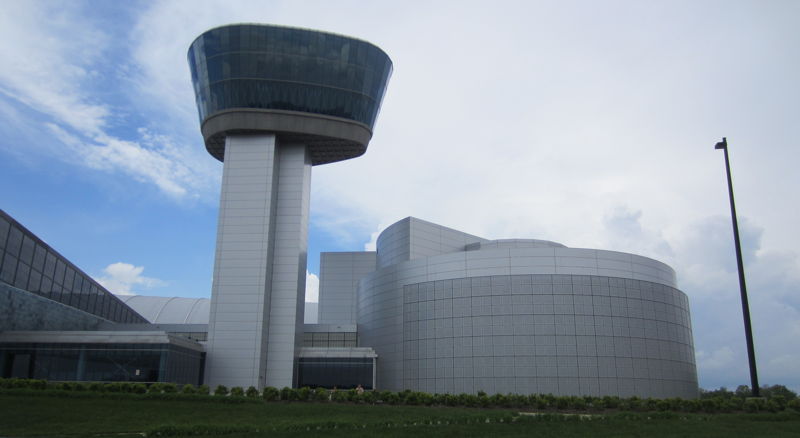
|
|
Smithsonian Air & Space Museum
Photo 220 |
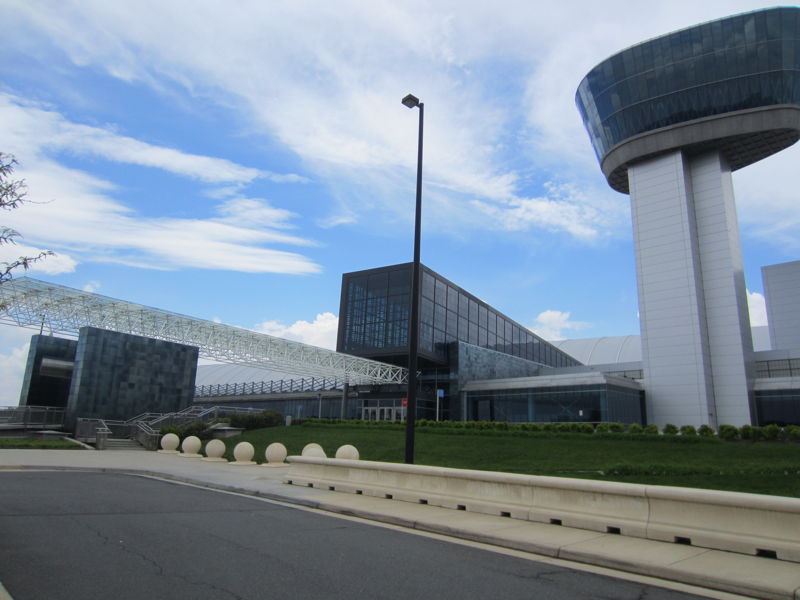
|
|
Langley Aerodrome A Samuel Langley's successful flights of his model Aerodromes Number 5 and Number 6 in 1896 led to plans to build a full-sized, human-carrying airplane. Langley's simple approach was merely to scale up the unpiloted Aerodromes to human-carrying proportions. This would prove to be a grave error, as the aerodynamics, structural design, and control system of the smaller aircraft were not adaptable to a full-sized version. Langley's primary focus was the power plant. The completed engine, a water-cooled five-cylinder radial that generated a remarkable 52.4 horsepower, was a great achievement for the time. Despite the excellent engine, the Aerodrome A, as it was called, met with disastrous results, crashing on takeoff on October 7, 1903, and again on December 8. Langley blamed the launch mechanism. While this was in some small measure true, there is no denying that the Aerodrome A was an overly complex, structurally weak, aerodynamically unsound aircraft. This second crash ended Langley's aeronautical work entirely. Photo 97 |
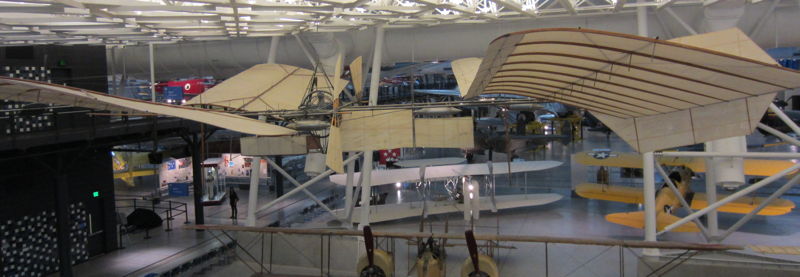
|
|
1908 Wright Military Flyer (Reproduction) The 1909 Wright Military Flyer is the world's first military airplane. In 1908, the U.S. Army Signal Corps sought competitive bids for a two-seat observation aircraft. Winning designs had to meet a number specified performance standards. Flight trials with the Wrights' entry began at Fort Myer, Virginia, on September 3, 1908. After several days of successful flights, tragedy occurred on September 17, when Orville Wright crashed with Lt. Thomas 0. Selfridge, the Army's observer, as his passenger. Orville survived with severe injuries, but Selfridge was killed, becoming the first fatality in a powered airplane. On June 3, 1909, the Wrights returned to Fort Myer with a new airplane to complete the trials begun in 1908. Satisfying all requirements, the Army purchased the airplane for $30,000, and conducted flight training with it at nearby College Park, Maryland, and at Fort Sam Houston, in San Antonio, Texas, in 1910. It was given to the Smithsonian in 1911. Photo 210 |
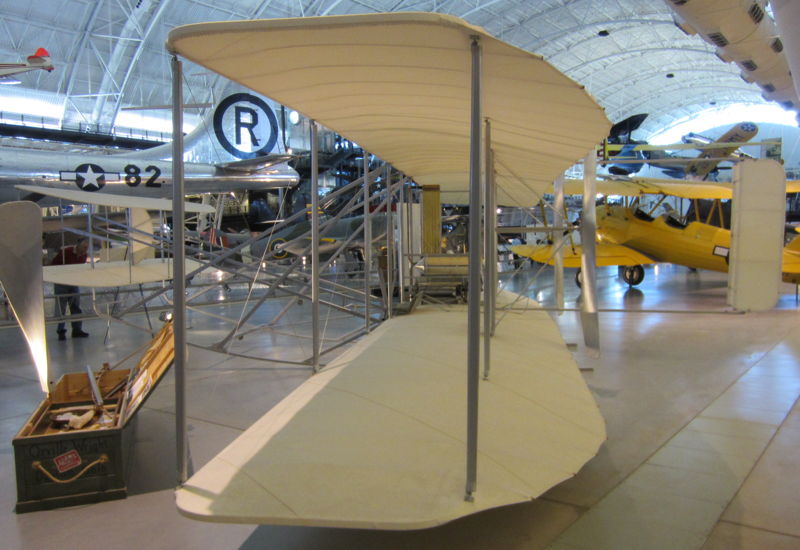
|
|
1908 Wright Military Flyer (Reproduction)
Photo 213 |
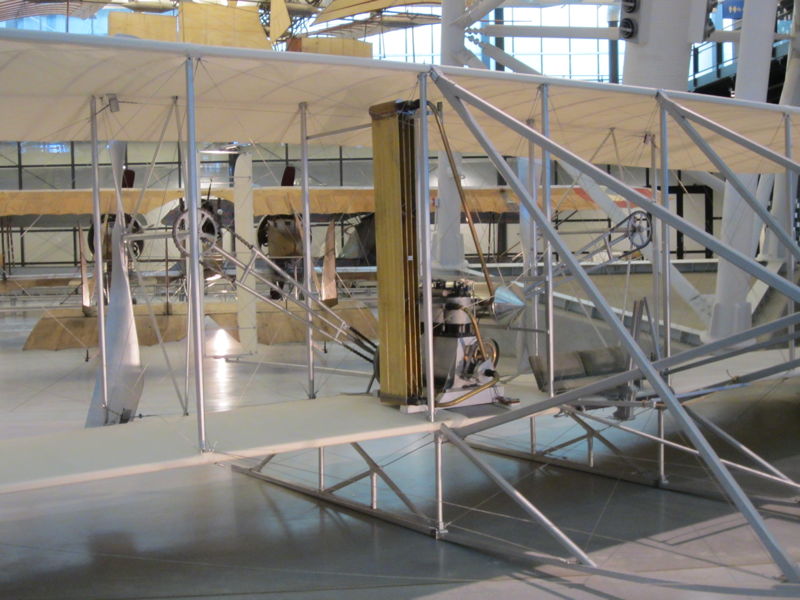
|
|
Farman Sport The Farman FF 65 Sport was a French built light biplane, with a single engine and tandem seats, intended for sport and touring. First flown in 1919, it achieved modest sales at home and abroad in the early 1920s. Two unusual modifications produced a biplane glider and a low aspect ratio parasol wing machine. In 1919, the H.& M. Farman Aeroplane Company of France produced the Farman Sport two-place sport and light commercial biplane. In 1922, C.T. Ludington and Wallace Kellett of Philadephia, Pennsylvania, formed the Ludington Exhibition Company as agents for Farman aircraft, and in 1923, they imported their first two Sports. Their pilot flew this aircraft, serial number 15, C-72, in the 1924 "On to Dayton Race," which included flying over the treacherous Allegheny Mountains. After suffering severe damage in 1928, NC-72's airworthiness certificate was revoked and it languished for years in Pennsylvania and New Jersey until Ken Hyde of Warrenton, Virginia, restored it. C.T. Ludington himself identified the aircraft, allowing Hyde to reclaim the NC-72 registration. This is the last remaining Farman Sport. Photo 91 |
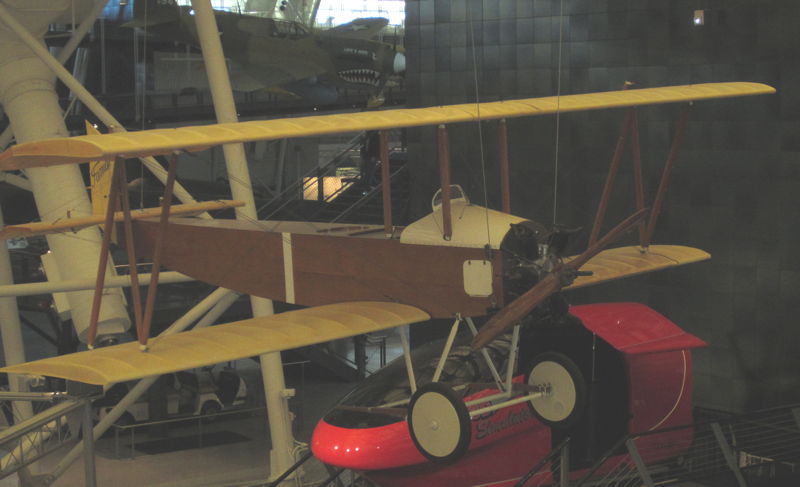
|
|
Benoist-Korn Type XII In the spring of 1912 Thomas Wesley Benoist announced the completion of his firm's newest aircraft, the Type XII. It was a two-place tractor biplane, powered by a Roberts six-cylinder, 75-horsepower engine. It was one of the first closed-fuselage tractor airplanes to appear in the United States. Perhaps five Type XII aircraft were produced by the Benoist factory during the next year. The NASM Benoist Type XII was constructed in the Benoist shop in St. Louis by its purchasers, Edward and Milton Korn. The Korn brothers began work on their airplane in March 1912. It was completed on May 20, and it was flown soon thereafter at Anna, Illinois. During the following year, the Korns performed numerous exhibitions with their Benoist. Most American aircraft produced during this period were close copies of Wright, Curtiss, or European machines. Benoist was one of the very few U.S. firms building and selling original designs in the pioneer era. Photo 93 |
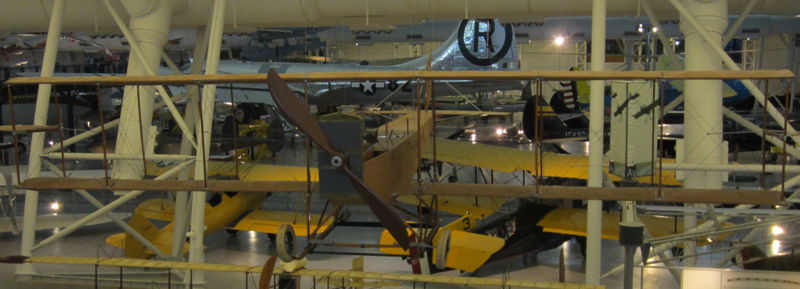
|
|
Baldwin Red Devil After making a reputation with lighter-than-air craft, Thomas Scott Baldwin turned to heavier-than-air flying machines in 1909. By 1911 he had built several airplanes and had gained extensive experience as an exhibition pilot. He began testing a new airplane in the spring of 1911. It was similar to the basic Curtiss pusher design that was becoming quite popular with builders by this time, but it was innovative in that it was constructed of steel tubing. It was powered by a 60-horsepower Hall-Scott V-8. Baldwin called his new machine the Red Devil III, and thereafter each of his airplanes would be known as a Baldwin Red Devil. Baldwin built approximately six Red Devils. Most were powered by the Hall-Scott, but Curtiss engines were also occasionally used. By mid-1911, Baldwin was training pilots, taking up passengers, and performing regularly with Red Devil aircraft at air meets. He advertised Red Devils for sale into 1913. Photo 190 |
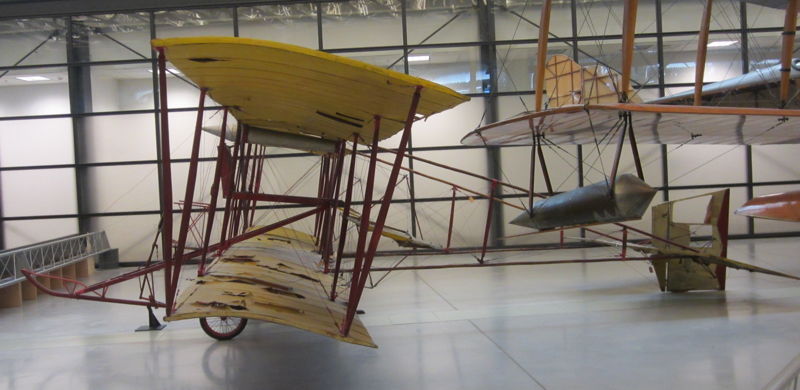
|
|
Nieuport 28C.1 The Nieuport 28 (N.28C-1) was a French biplane fighter aircraft flown during World War I, built by Nieuport and designed by Gustave Delage. Owing its lineage to the successful line of sesquiplane fighters that included the Nieuport 17, the Nieuport 28 continued a similar design philosophy of a lightweight and highly maneuverable aircraft. Rejected by the Aéronautique Militaire in favor of the SPAD XIII - its principal claim to fame is that it was the first aircraft to see service with an American fighter squadron, equipping four squadrons of the United States Air Service between March and August 1918. Photo 95 |
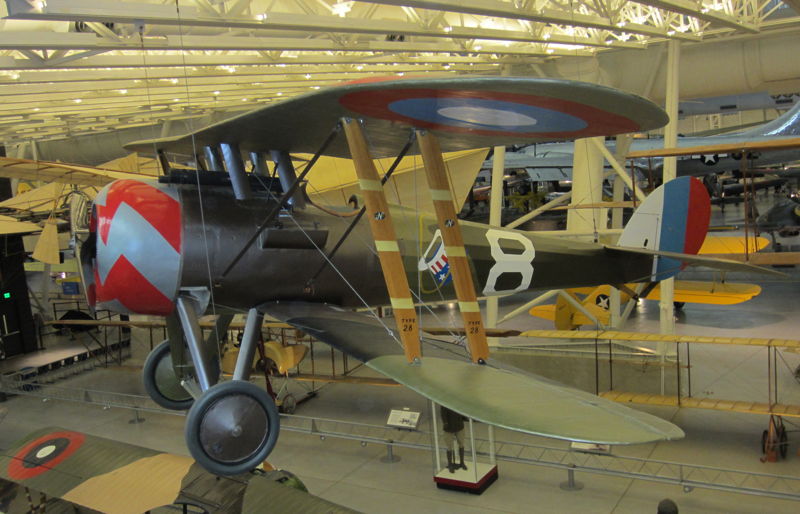
|
|
Naval Aircraft Factory N3N Seaplane The N3N was a United States two tandem-seat, open cockpit, primary training biplane aircraft built by the Naval Aircraft Factory (N.A.F.) in Philadelphia, Pennsylvania during the 1930s. Built to replace the Consolidated NY-2 and NY-3, the N3N was successfully tested as both a conventional airplane and a seaplane. The seaplane used a single float under the fuselage and floats under the outer tips of the lower wing. The conventional airplane used a fixed landing gear. The prototype XN3N-1 was powered by a radial Wright designed Wright J-5 engine. An order for 179 production aircraft was received. Near the end of the first production run the engine was replaced with the Wright R-760-2 Whirlwind radial. In 1934 the Naval Aircraft Factory in Philadelphia was tasked to manufacture a new primary trainer for the U.S. Navy. Following successful tests, this little biplane trainer was built in both land and seaplane versions. The Navy initially ordered 179 N3N-1 models, and the factory began producing more than 800 N3N-3 models in 1938. U.S. Navy primary flight training schools used N3Ns extensively throughout World War II. A few of the seaplane version were retained for primary training at the U.S. Naval Academy. In 1961 they became the last biplanes retired from U.S. military service. This N3N-3 was transferred from Cherry Point to Annapolis in 1946, where it served as a seaplane trainer. It was restored and displayed at the Naval Academy Museum before being transferred here. Photo 138 |
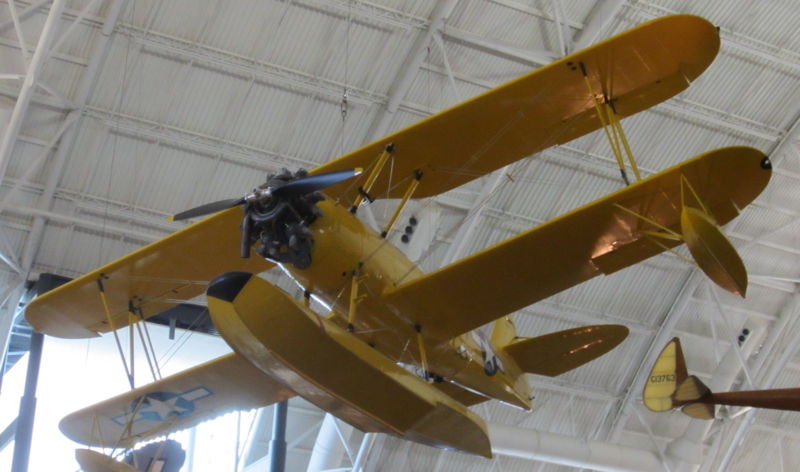
|
|
Naval Aircraft Factory N3N Seaplane
Photo 122 |
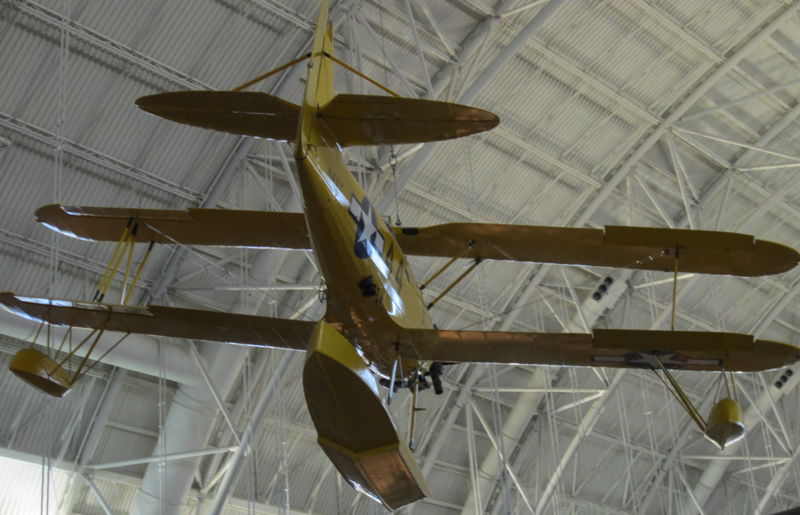
|
|
Naval Aircraft Factory N3N Seaplane
Photo 179 |
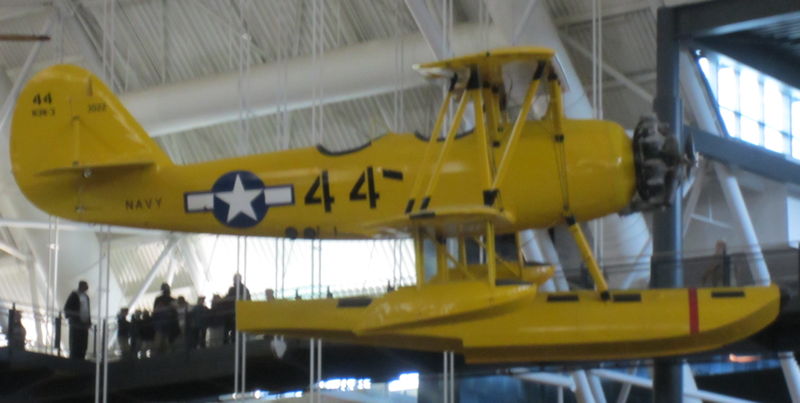
|
|
Loening OA-1A San Francisco The historic Pan-American Goodwill Flight of 1926 and 1927 through Mexico and Central and South America was intended to improve relations with Latin American countries, to encourage commercial aviation, and to provide valuable training for Air Corps personnel. The flight was made by ten pilots in five Loening OA-1A amphibian aircraft. To stimulate public interest, each airplane was named after a major U.S. city-the New York, the San Antonio, the San Francisco, the Detroit, and the St. Louis. The 22,000 mile flight began on December 21, 1926, from San Antonio, Texas. The journey took 59 flying days, interspersed with 74 days for scheduled maintenance and diplomatic meetings and ceremonies. The flight concluded at Bolling Field in Washington, D.C., on May 2, 1927. Within three weeks, however, the impressive achievement was eclipsed by Lindbergh's solo trans-Atlantic flight in the Spirit of St. Louis. The San Francisco was transferred to the Smithsonian Institution by the War Department in December 1927. It was restored by the National Air and Space Museum in 1964-1965. Photo 187 |
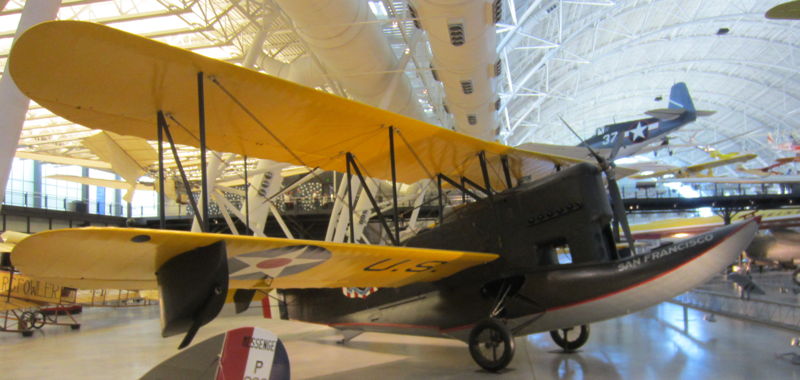
|
|
Curtiss N-9H The Curtiss N-9H was a seaplane version of the famous Curtiss JN-4D trainer used by the U.S. Air Service during the First World War. To make the conversion, a single large central pontoon was mounted below the fuselage, with a small float fitted under each wingtip. These changes required a 10-foot increase in wingspan to compensate for the additional weight. During the war, 2,500 Navy pilots were trained on the N-9H. In addition to training a generation of Navy pilots, the N-9H was used to develop tactics for ship-borne aircraft operations in 1916 and 1917, using catapults mounted on armored cruisers. After the war, the airplane was again employed to successfully demonstrate a compressed air turntable catapult. In July 1917, several N-9Hs were acquired by the Sperry Gyroscope Company and were used as test vehicles for aerial torpedo experiments conducted for the Navy's Bureau of Ordnance. The N-9H was withdrawn from the U.S. Navy inventory in 1927 after ten years of exemplary service. Photo 192 |
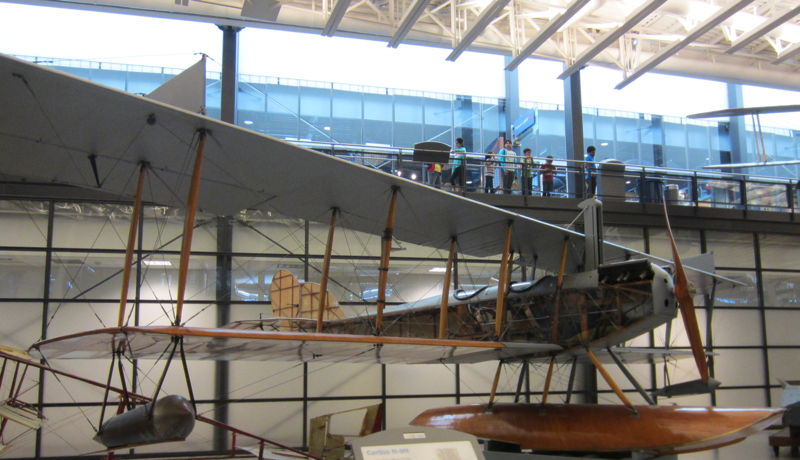
|
|
Caudron G.4 The 1917 French twin-engine Caudron G.4 has great significance as an early light bomber and reconnaissance aircraft. It was a principal type used when these critical air power missions were being conceived and pioneered in World War I. Although fighter aircraft frequently gain greater attention, the most influential role of aviation in the First World War was reconnaissance. The extensive deployment of the Caudron G.4 in this role makes it an especially important early military aircraft. Moreover, despite its speed and armament limitations, the Caudron G.4 was quite reliable, had a good rate of climb, and was pleasant to fly, all characteristics that made it a good training aircraft after its combat effectiveness was reduced. Many Allied pilots received their initial flight training on the Caudron G.4. The NASM Caudron is among the oldest surviving bomber aircraft in the world, and one of the very few remaining multi-engine aircraft from this period. Photo 196 |
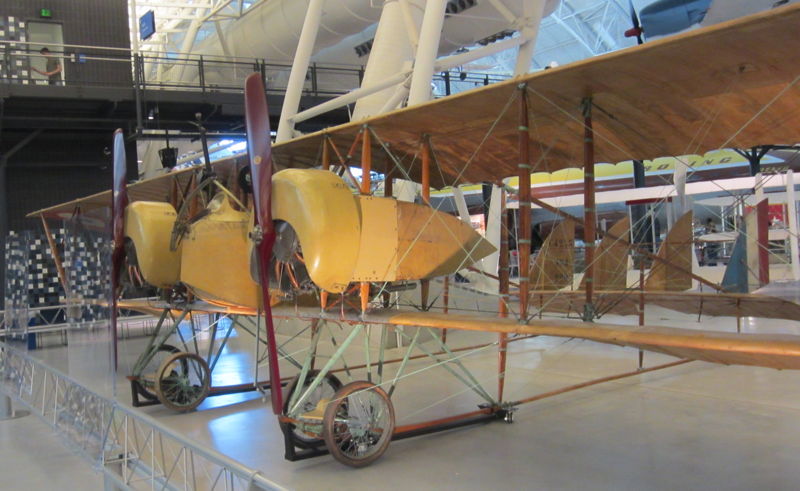
|
|
Caudron G.4
Photo 98 |

|
|
Halberstadt CL.IV The effective ground attack capabilities of the earlier Halberstadt CL.II were realized late in 1917. With this successful adaptation of the CL.II, design work began on an improved version, specifically intended for the ground attack role. The Halberstadt CL.IV was one of the best ground attack aircraft of World War I. It performed well in combat as a low-level attack airplane, relying on its good maneuverability to avoid ground fire. After supporting the desperate late German offensives in 1918, Halberstadt CL.IVs were used to disrupt advancing Allied offensives by striking at enemy troop assembly points. When not on close support or ground attack missions, it was used as a standard two-seat fighter for escort work. Towards the end of the war, on bright, moonlit nights, CL.IV squadrons attempted to intercept and destroy Allied bombers as they returned from their missions. Night sorties against Allied airfields were also made with the CL.IV. Photo 198 |
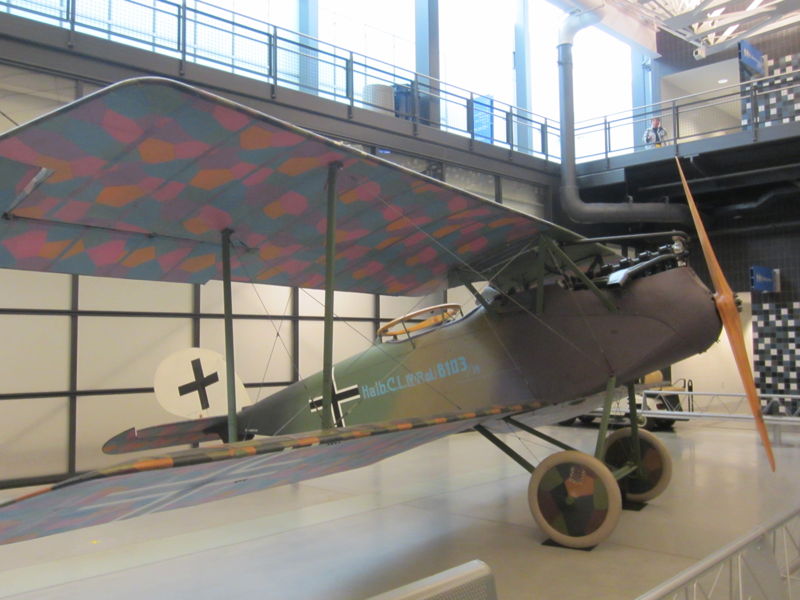
|
|
Turner RT-14 Meteor Following his first Thompson Trophy victory in 1934, famed racing pilot Roscoe Turner contracted with the Lawrence W. Brown Aircraft Company to build a new racing aircraft. Designed by Turner and engineered by University of Minnesota professor Howard Barlow, the Turner racer was completed in mid-1936. Following flight tests, Matty Laird extensively redesigned the aircraft and added a larger wing and flaps. Known as the Laird Turner LTR-14 and later the Turner RT-14, the modified racer placed third in the 1937 Thompson Trophy event at the National Air Races and won the 1938 and 1939 contests. With this aircraft, Turner became the only three-time winner of the Thompson Trophy. In 1939 the aircraft was sponsored by Champion Spark Plugs and therefore carried the name "Miss Champion" on its fuselage. Photo 217 |
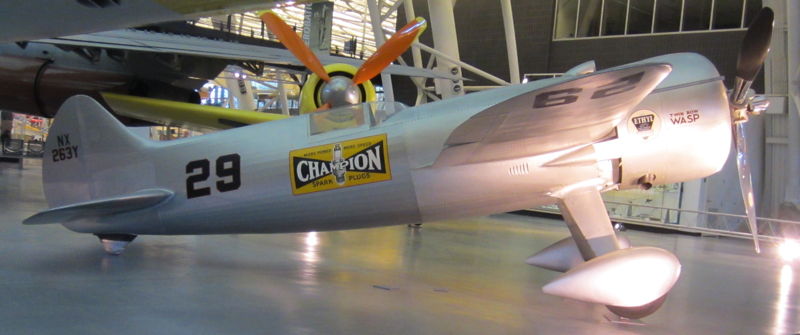
|
|
Piper J-3 Cub The Piper J-3 Cub is a small, simple, light aircraft that was built between 1937 and 1947 by Piper Aircraft. With tandem (fore and aft) seating, it was intended for flight training but became one of the most popular and best-known light aircraft of all time. The Cub's simplicity, affordability and popularity invokes comparisons to the Ford Model T automobile. The aircraft's standard chrome yellow paint has come to be known as “Cub Yellow” or "Lock Haven Yellow" Photo 104 |
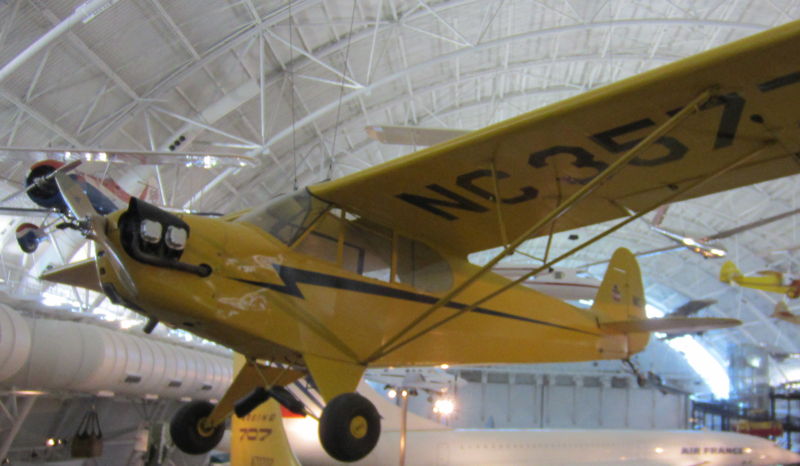
|
|
United States Army Air Corps — Boeing P-26 Peashooter The Boeing P-26A of the mid-to-late 1930s introduced the concept of the high-performance, all-metal monoplane fighter design, which would become standard during World War II. A radical departure from wood-and-fabric biplanes, the Peashooter nonetheless retained an open cockpit, fixed landing gear, and external wing bracing. Most P-26As stationed overseas were eventually sold to the Philippines or assigned to the Panama Canal Department Air Force, a branch of the U.S. Army Air Corps. Several went to China and one to Spain. This one was based at Selfridge Field in Michigan and Fairfield Air Depot in Ohio between its acceptance by the U.S. Army Air Corps in 1934 and its transfer to the Canal Zone in 1938. It was given to Guatemala in 1942 and flew in the Guatemalan air force until 1954. Guatemala donated it to the Smithsonian in 1957. Photo 130 |
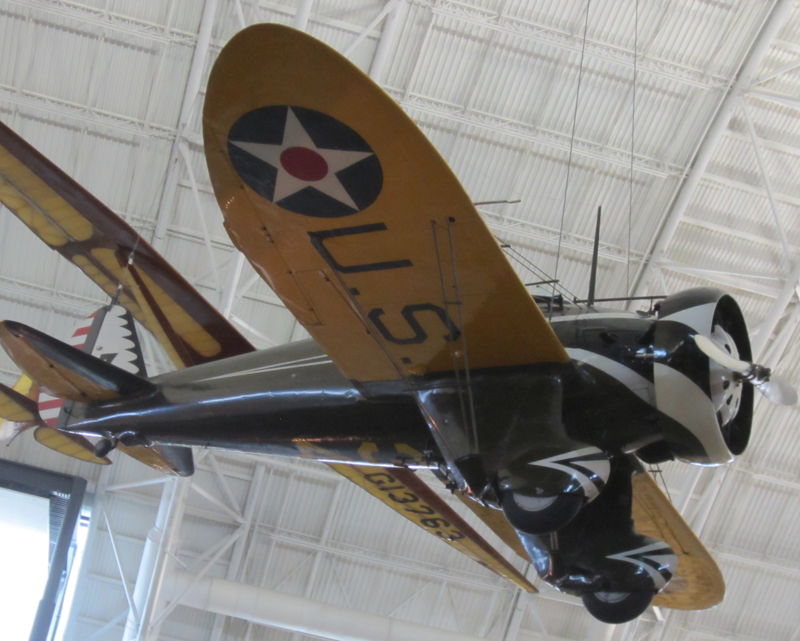
|
|
Westland Lysander The Westland Lysander was a British army co-operation and liaison aircraft produced by Westland Aircraft used immediately before and during the Second World War. After becoming obsolete in the army co-operation role, the aircraft's exceptional short-field performance enabled clandestine missions using small, unprepared airstrips behind enemy lines to place or recover agents, particularly in occupied France with the French Resistance help. Like other British army air co-operation aircraft it was given the name of a mythical or legendary leader, in this case the Spartan general Lysander. Photo 126 |
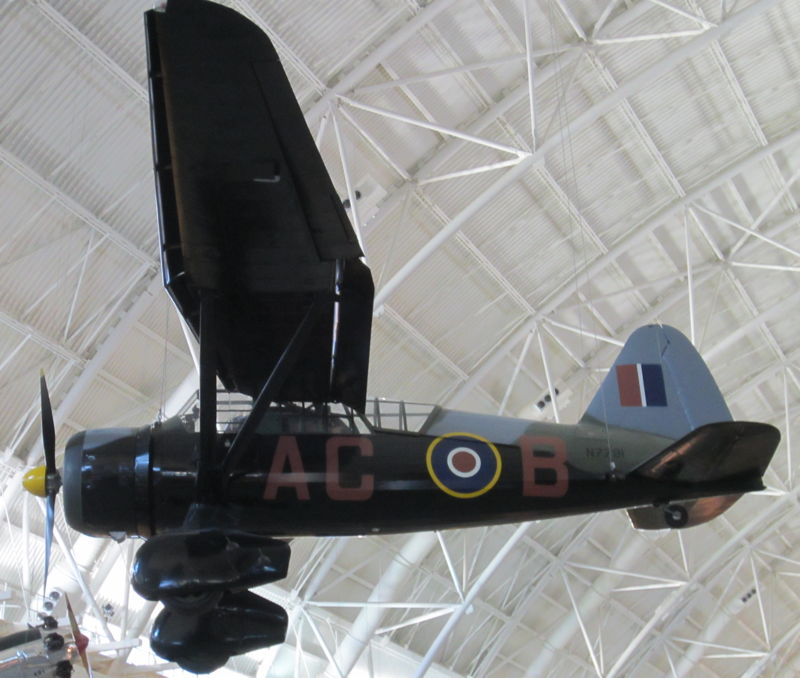
|
|
unknown 5
Photo 127 |
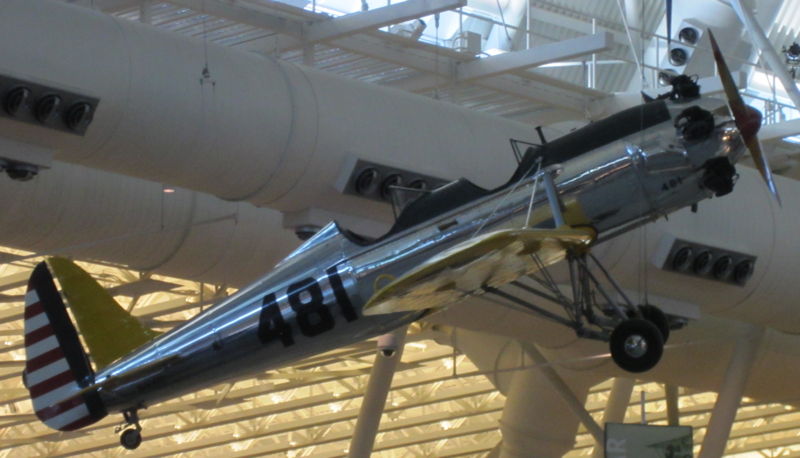
|
|
Northrop N-1M Jeep The Northrop N-1M was an early flying wing aircraft, predecessor to the Northrop N-9M and Northrop YB-35. This aircraft, the first true flying wing produced in the United States, was developed during 1939 and 1940, and first flew on 3 July 1941 at Baker Dry Lake in California. Unstable and underpowered, but basically sound, the N-1M paved the way for Northrop's later flying wings. The plane was donated to the United States Army Air Forces in 1945 and was placed in the collection of the National Air Museum the following year. It is now on public display at the National Air and Space Museum's Steven F. Udvar-Hazy Center. Photo 120 |

|
|
Grumman F6F Hellcat This Grumman F6F-3 Hellcat (BuNo. 41834) was delivered to the US Navy in February 1943. It would go on to serve as an unmanned sampling drone during the Operation Crossroads atomic bomb tests in 1946. After a number of years spent outdoors at the USS Yorktown museum, the aircraft was restored by Grumman volunteers in 1982 before being returned to the Smithsonian in 1985. It was kept in storage at the Garber Facility until being placed on display at the Udvar-Hazy Center in 2004. Photo 100 |

|
|
North American P-51C Mustang Excaliber III This is Excalibur III, the war-surplus North American Aviation (NAA) P-51C Mustang racer owned originally by Paul Mantz and then Charles F. Blair, and flown by the likes of Mantz, Linton Carney, Herman "Fish" Salmon, and Blair in a number of races and record setting flights. Photo 102 |
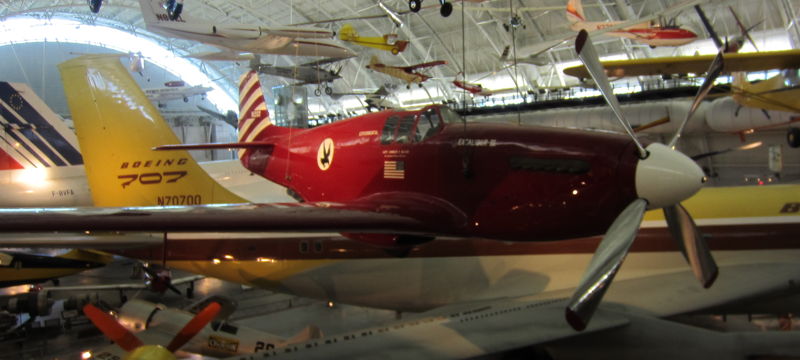
|
|
North American P-51C Mustang Excaliber III
Photo 202 |
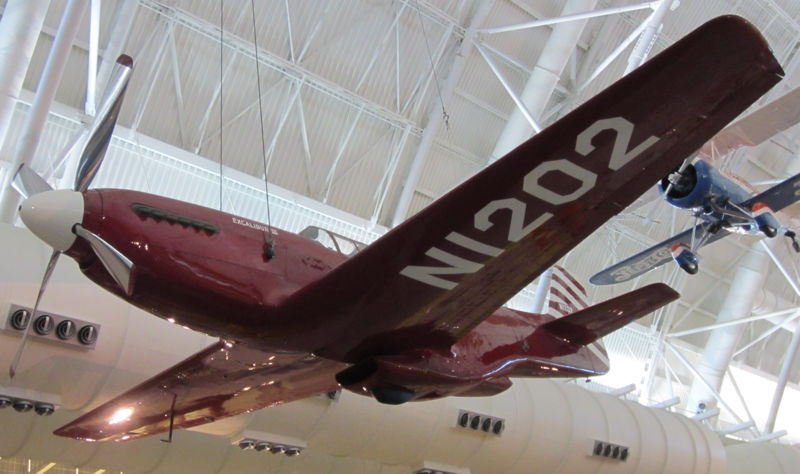
|
|
unknown 2
Photo 115 |
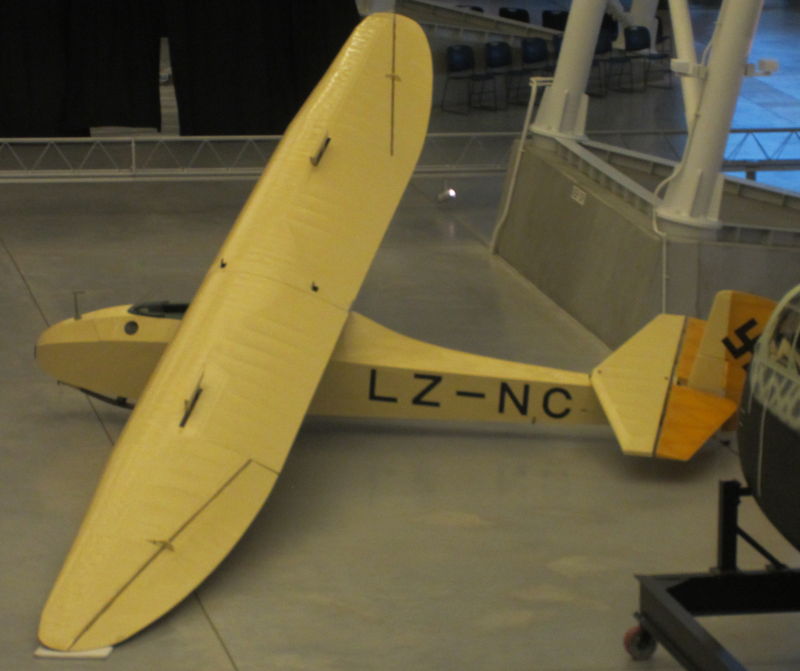
|
|
Chance Vought F4U-1D Corsair The Chance Vought F4U Corsair was a carrier-capable fighter aircraft that saw service primarily in World War II and the Korean War. The Corsair served in the U.S. Navy, U.S. Marines, Fleet Air Arm and the Royal New Zealand Air Force, as well as the French Navy Aéronavale and other, smaller, air forces until the 1960s. It quickly became the most capable carrier-based fighter-bomber of World War II. Some Japanese pilots regarded it as the most formidable American fighter of World War II. By V-J Day, September 2, 1945, Corsair pilots had amassed an 11:1 kill ratio against enemy aircraft. The aircraft's distinctive inverted gull-wing design allowed ground clearance for the huge, three-bladed Hamilton Standard Hydromatic propeller, which spanned more than 4 meters (13 feet). The Pratt and Whitney R-2800 radial engine and Hydromatic propeller was the largest and one of the most powerful engine-propeller combinations ever flown on a fighter aircraft. Charles Lindbergh flew bombing missions in a Corsair with Marine Air Group 31 against Japanese strongholds in the Pacific in 1944. The United States Navy donated an F4U-1D to the National Air and Space Museum in September 1960. Vought delivered this Corsair, Bureau of Aeronautics serial number 50375, to the Navy on April 26, 1944. By October, pilots of VF-10 were flying it but in November, the airplane was transferred to VF-89 at Naval Air Station Atlantic City. It remained there as the squadron moved to NAS Oceana and NAS Norfolk. During February 1945, the Navy withdrew the airplane from active service and transferred it to a pool of surplus aircraft stored at Quantico, Virginia. In 1980, NASM craftsmen restored the F4U-1D in the colors and markings of a Corsair named "Sun Setter," a fighter assigned to Marine Fighter Squadron VMF-114 when that unit served aboard the "USS Essex" in July 1944. Photo 128 |
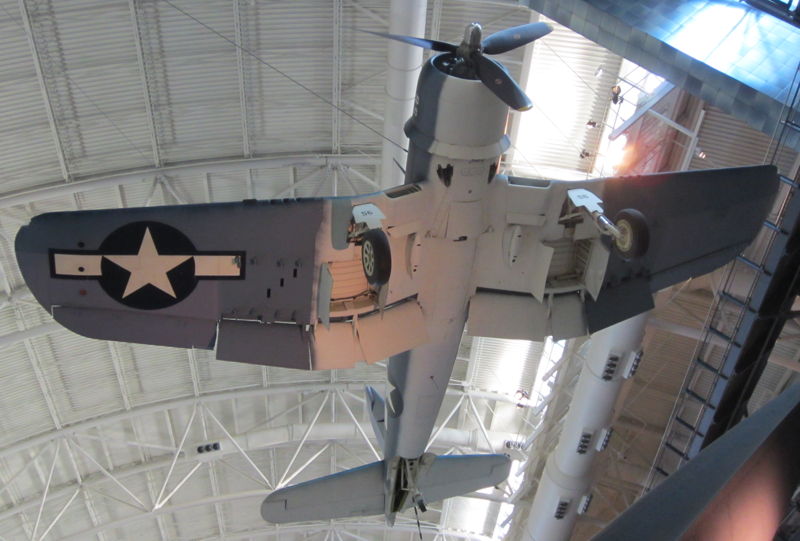
|
|
Curtiss P-40E Warhawk The Curtiss P-40 Warhawk was an American single-engine, single-seat, all-metal fighter and ground attack aircraft that first flew in 1938. The Warhawk was used by most Allied powers during World War II, and remained in front line service until the end of the war. It was the third most-produced American fighter. Whether known as the Warhawk, Tomahawk, or Kittyhawk, the Curtiss P-40 proved to be a successful, versatile fighter during the first half of World War II. The shark-mouthed Tomahawks that Gen. Claire Chennault's "Flying Tigers" flew in China against the Japanese remain among the most popular airplanes of the war. P-40E pilot Lt. Boyd D. Wagner became the first American ace of World War II when he shot down six Japanese aircraft in the Philippines in mid-December 1941. Curtiss-Wright built this airplane as Model 87-A3 and delivered it to Canada as a Kittyhawk I in 1941. It served until 1946 in No. 111 Squadron, Royal Canadian Air Force. U.S. Air Force personnel at Andrews Air Force Base restored it in 1975 to represent an aircraft of the 75th Fighter Squadron, 23rd Fighter Group, 14th Air Force. Photo 139 |
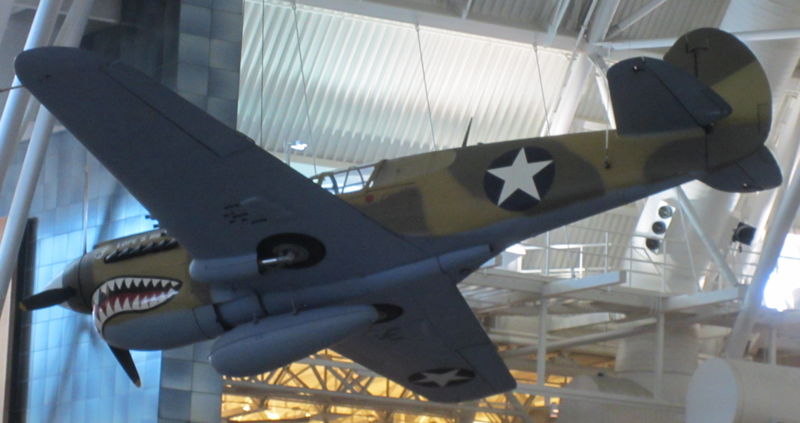
|
|
Curtiss P-40E Warhawk
Photo 184 |
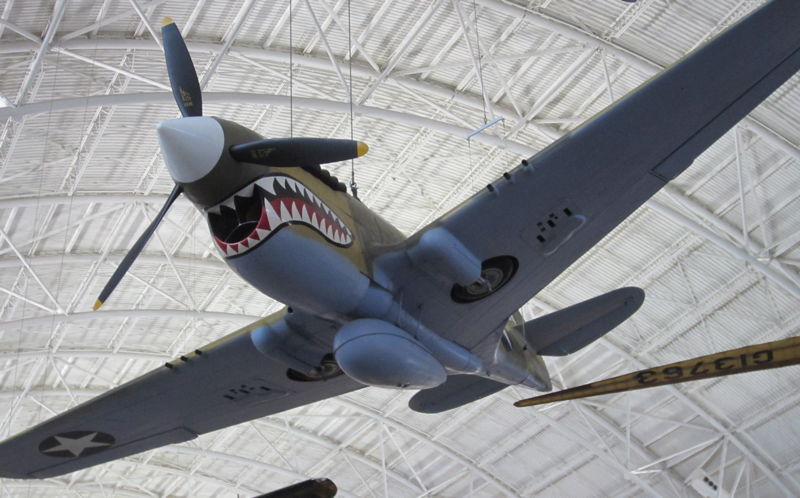
|
|
Boeing B-29 Superfortress Enola Gay Boeing's B-29 Superfortress was the most sophisticated propeller-driven bomber of World War II and the first bomber to house its crew in pressurized compartments. Although designed to fight in the European theater, the B-29 found its niche on the other side of the globe. In the Pacific, B-29s delivered a variety of aerial weapons: conventional bombs, incendiary bombs, mines, and two nuclear weapons. On August 6, 1945, this Martin-built B-29-45-MO dropped the first atomic weapon used in combat on Hiroshima, Japan Photo 107 |
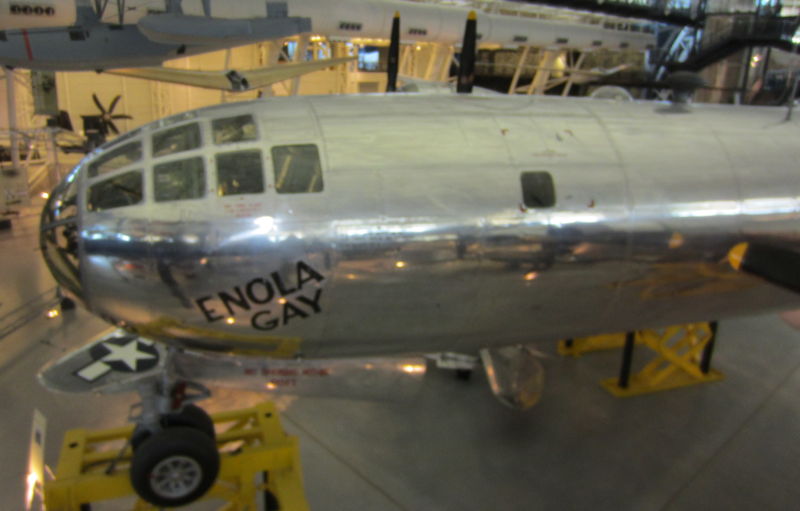
|
|
Enola Gay
Photo 200 |
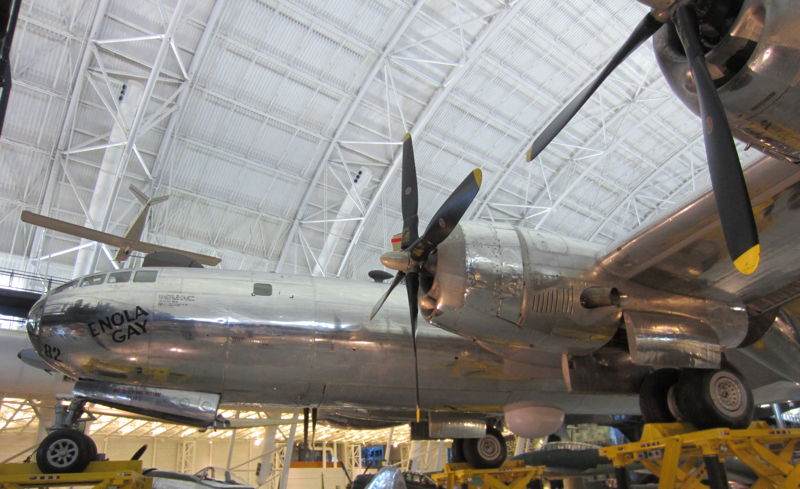
|
|
Enola Gay
Photo 201 |
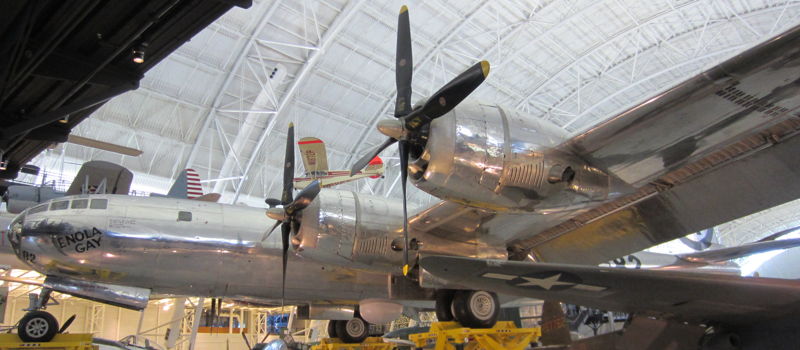
|
|
Northrop P-61C Black Widow The P-61 Black Widow was the first U.S. aircraft designed to locate and destroy enemy aircraft at night and in bad weather, a feat made possible by the use of on-board radar. The prototype first flew in 1942. P-61 combat operations began just after D-Day, June 6, 1944, when Black Widows flew deep into German airspace, bombing and strafing trains and road traffic. Operations in the Pacific began at about the same time. By the end of World War II, Black Widows had seen combat in every theater and had destroyed 127 enemy aircraft and 18 German V-1 buzz bombs. The Museum’s Black Widow, a P-61C-1-NO, was delivered to the Army Air Forces in July 1945. Used by NACA (National Advisory Committee for Aeronautics) and the US Weather Service, it participated in cold-weather tests, high-altitude drop tests, and in the National Thunderstorm Project, for which the top turret was removed to make room for thunderstorm monitoring equipment. Photo 186 |
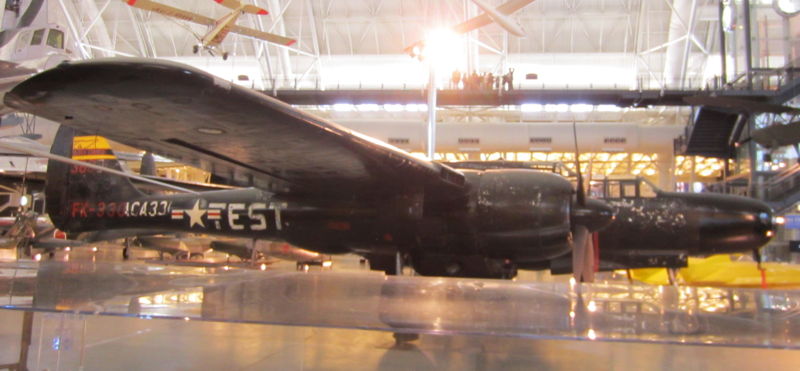
|
|
Lockheed P-38J Lightning In the P-38 Lockheed engineer Clarence "Kelly" Johnson and his team of designers created one of the most successful twin-engine fighters ever flown by any nation. From 1942 to 1945, U. S. Army Air Forces pilots flew P-38s over Europe, the Mediterranean, and the Pacific, and from the frozen Aleutian Islands to the sun-baked deserts of North Africa. Lightning pilots in the Pacific theater downed more Japanese aircraft than pilots flying any other Allied warplane. Maj. Richard I. Bong, America's leading fighter ace, flew this P-38J-10-LO on April 16, 1945, at Wright Field, Ohio, to evaluate an experimental method of interconnecting the movement of the throttle and propeller control levers. However, his right engine exploded in flight before he could conduct the experiment. Photo 204 |
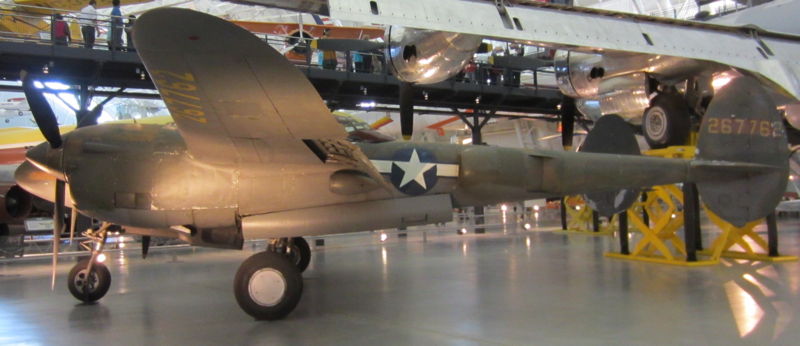
|
|
Lockheed P-38J Lightning
Photo 199 |
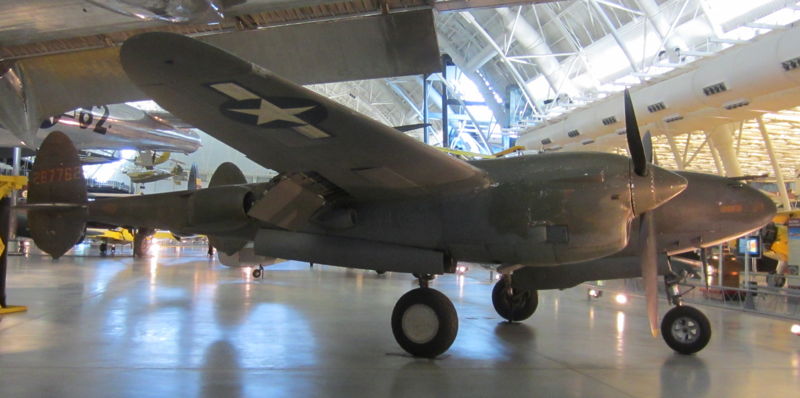
|
|
Hawker Hurricane IIC Hawker Chief Designer Sydney Camm's Hurricane ranks with the most important aircraft designs in military aviation history. Designed in the late 1930s, when monoplanes were considered unstable and too radical to be successful, the Hurricane was the first British monoplane fighter and the first British fighter to exceed 300 miles per hour in level flight. Hurricane pilots fought the Luftwaffe and helped win the Battle of Britain in the summer of 1940. This Mark IIC was built at the Langley factory, near what is now Heathrow Airport, early in 1944. It served as a training aircraft during the World War II in the Royal Air Force's 41 OTU. During the late 1960s, the Smithsonian arranged to trade a stock Hawker Typhoon to the Royal Air Force Museum at Hendon in exchange for Hawker Hurricane LF686. An RAF transport hauled the fighter to the U. S. in 1969. Specialists at the Garber Facility began restoring the airplane in 1989 and finished the project eleven years later. The fighter is on display at the Steven F. Udvar-Hazy Center. Photo 205 |
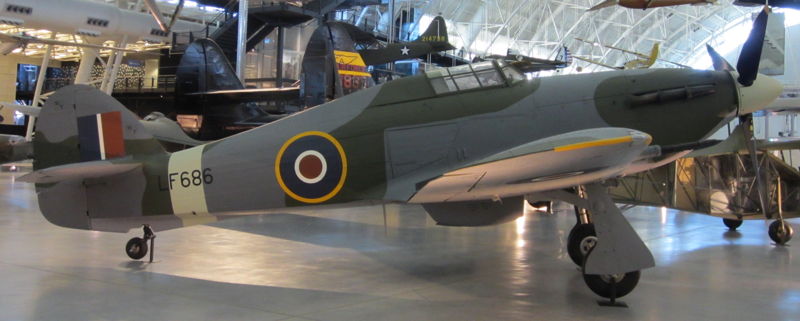
|
|
Hawker Hurricane IIC
Photo 214 |
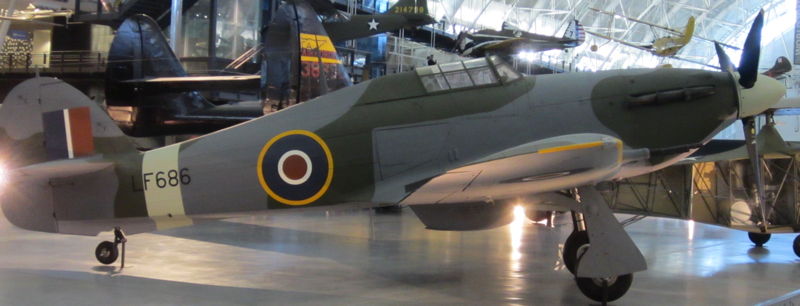
|
|
Boeing 307 Stratoliner Clipper Flying Cloud The Clipper Flying Cloud was delivered to Pan American Airways (PAA) with two others in 1940. The aircraft carried 33 passengers and a crew of five. The Pan American Airways airplane was reconfigured to seat 45 passengers. Stratoliners included space for berths for overnight travel; paneling in the cabin and lavatory; wall fabric featuring the Pan Am logo, world map and exotic animals; and eight divans. The Clipper Flying Cloud began service flying Caribbean routes for two years. During World War II, it flew in South America under the direction of the U.S. Army Air Forces. In 1946, it made daily runs between New York and Bermuda. Throughout the next two decades it passed through the hands of several owners, and once served as a presidential plane for the notorious Haitian leader "Papa Doc" Duvalier. After its Haitian sojourn, the Clipper Flying Cloud landed in Arizona. The Smithsonian subsequently acquired the aircraft and later made arrangements with the Boeing Company for the restoration, dubbed "Operation Flying Cloud," at the Seattle plant where the Stratoliner was originally built. On March 28, 2002 this particular aircraft ditched into Elliott Bay in Seattle, Wash., on what was to be its last flight before heading to the Smithsonian. Despite the incident, it was again restored, flew to the Smithsonian and is now on display Photo 207 |
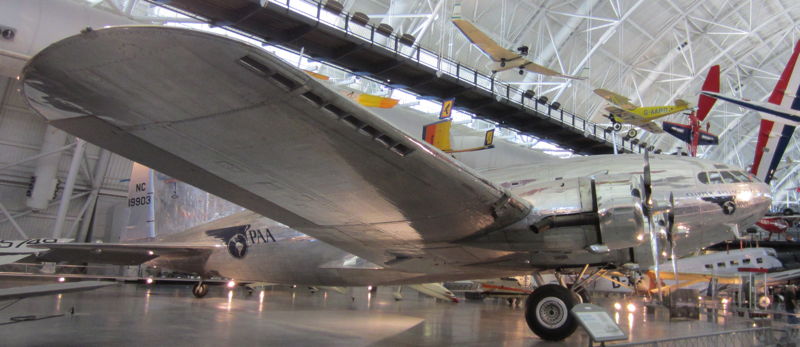
|
|
Arado Ar 234 B Blitz The Arado Ar 234 B Blitz (Lightning) was the world's first operational jet bomber and reconnaissance aircraft. The first Ar 234 combat mission, a reconnaissance flight over the Allied beachhead in Normandy, took place August 2, 1944. With a maximum speed of 735 kilometers (459 miles) per hour, the Blitz easily eluded Allied piston engine fighters. While less famous than the Messerschmitt Me 262 jet fighters, the Ar 234s that reached Luftwaffe units provided excellent service, especially as reconnaissance aircraft. This Ar 234 B-2 served with bomber unit KG 76 from December 1944 until May 1945, when British forces captured it in Norway. Turned over to the United States, it was brought to Wright Field, Ohio, in 1946 for flight testing. In 1949 it was transferred to the Smithsonian, which restored it in 1984-89. This Arado is the sole survivor of its type. Photo 116 |
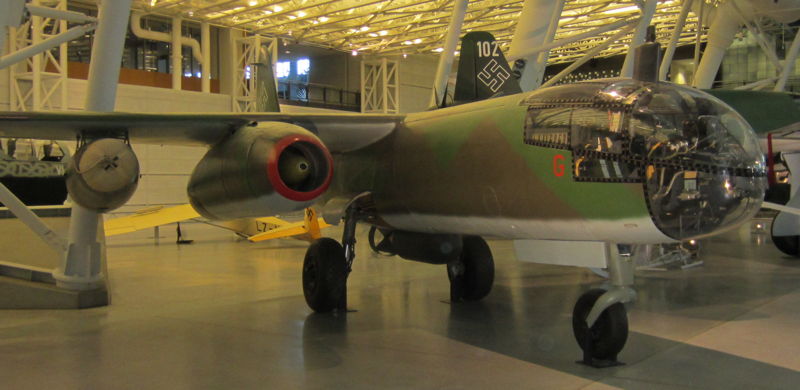
|
|
Dornier Do 335 A Pfiel Only one Do 335 survives today. The aircraft was the second preproduction Do 335A-0, designated A-02, with construction number (Werknummer) 240102, and factory radio code registration, or Stammkennzeichen, of VG+PH. The aircraft was assembled at Dornier's plant in Oberpfaffenhofen (southern Germany) on 16 April 1945. It was captured by allied forces at the plant on 22 April 1945. The aircraft was test flown from a grass runway at Oberwiesenfeld, near Munich, to Cherbourg, France while escorted by two P-51s. The Do 335 was easily able to out distance the escorting Mustangs and arrived at Cherbourg 45 minutes before the P-51s. VG+PH was one of two Do 335s to be shipped to the United States aboard the Royal Navy ship HMS Reaper, along with other captured German aircraft, to be used for testing and evaluation under a USAAF program called "Operation Sea Horse". In October 1974, VG+PH was returned to the Dornier plant in Oberpfaffenhofen, Germany (then building the Alpha Jet) for a complete restoration. In 1975, the aircraft was restored by Dornier employees, many of whom had worked on the airplane originally. They were amazed to find that the explosive charges built into the aircraft to blow off the tail fin and rear propeller in the event of an emergency were still on the aircraft and active 30 years later. Following restoration the completed Do 335 was displayed at the Hanover, Germany Airshow from 1 May to 9 May 1976. After the air show, the aircraft was lent to the Deutsches Museum in Munich where it was on display, without a swastika on the dorsal vertical tail in accordance with German law until 1986, when it was shipped back to Silver Hill, Maryland. VG+PH can be seen today in the Steven F. Udvar-Hazy Center of the National Air & Space Museum Photo 119 |
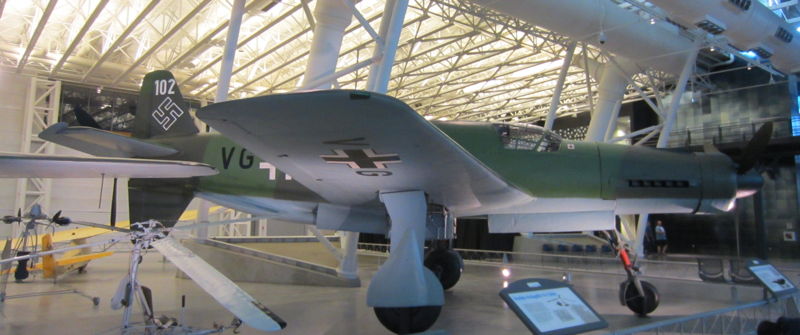
|
|
The Messerschmitt Me 163 Komet, designed by Alexander Lippisch, was a German rocket-powered fighter aircraft. It is the only rocket-powered fighter aircraft ever to have been operational. Its design was revolutionary, and the Me 163 was capable of performance unrivaled at the time. Messerschmitt test pilot Rudy Opitz in 1944 reached 698 mph. Over 300 aircraft were built; however, the Komet proved ineffective as a fighter, having been responsible for the destruction of only about nine Allied aircraft. Photo 132 |
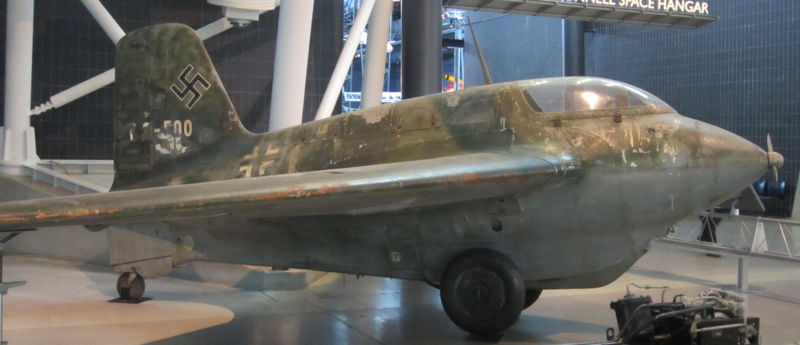
|
|
Messerschmitt Me 163 Komet
Photo 140 |
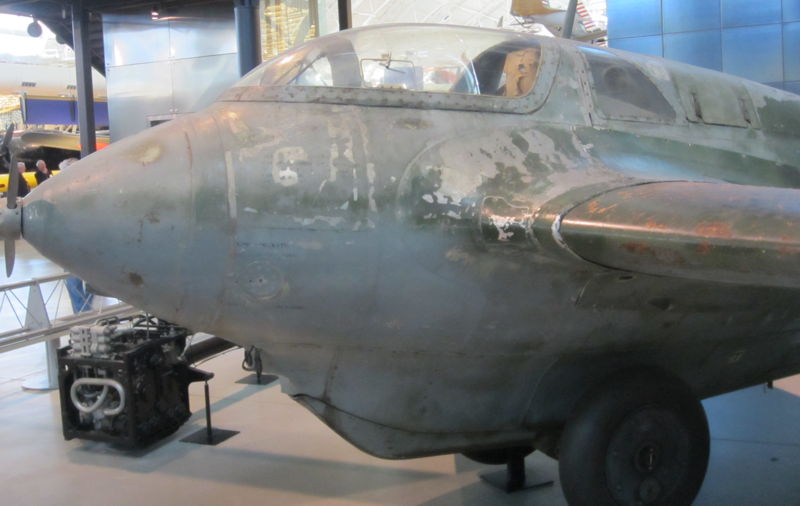
|
|
Walter Rocket Engine Powered German Me 163 Photo 133 |
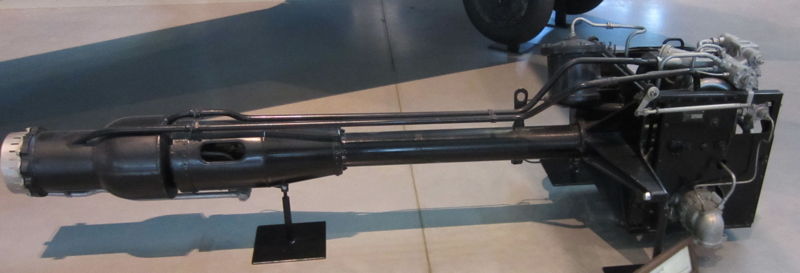
|
|
Lockheed SR-71 Blackbird No reconnaissance aircraft in history has operated in more hostile airspace or with such complete impunity than the SR-71 Blackbird. It is the fastest aircraft propelled by air-breathing engines. On March 6, 1990, the service career of one Lockheed SR-71A Blackbird ended with a record-setting flight. This special airplane bore Air Force serial number 64-17972. Lt. Col. Ed Yeilding and his RSO, Lieutenant Colonel Joseph Vida, flew this aircraft from Los Angeles to Washington D.C. in 1 hour, 4 minutes, and 20 seconds, averaging a speed of 3,418 kph (2,124 mph). At the conclusion of the flight, '972 landed at Dulles International Airport and taxied into the custody of the Smithsonian's National Air and Space Museum. Photo 137 |
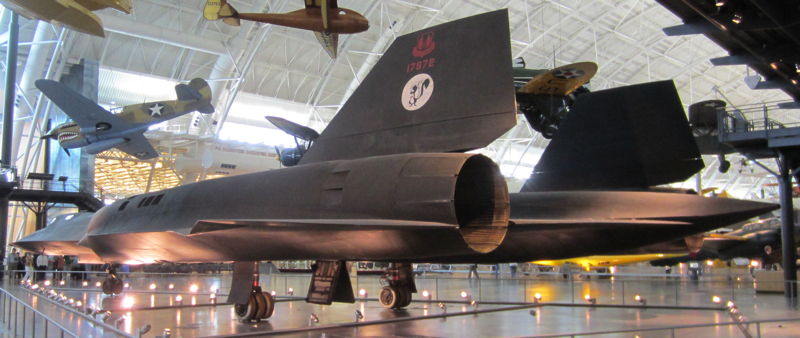
|
|
ST-71, engine exhaust
Photo 129 |
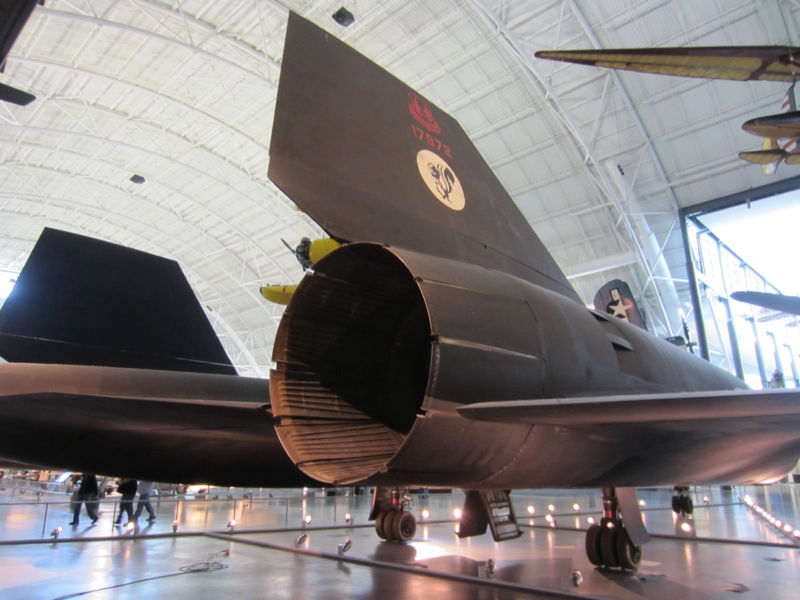
|
|
SR-71
Photo 182 |
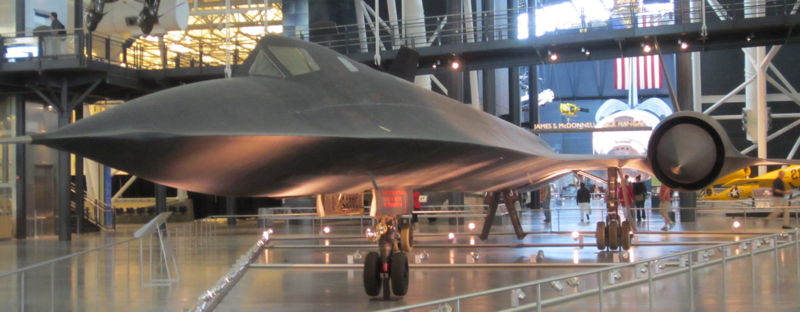
|
|
North American F-86A Sabre America's first swept-wing jet fighter, the F-86 Sabre joined the ranks of great fighter aircraft during combat operations high above the Yalu River in Korea. Even though they could not pursue the enemy across the Chinese border, Sabre pilots established an impressive shoot-down advantage against enemy MiGs. Sabre designers capitalized on captured German aerodynamic data, which showed that swept wings delayed air compressibility effects encountered at high subsonic airspeeds. Swept-wing aircraft could therefore be controlled at much higher speeds than similar straight-wing aircraft. This F-86A saw combat against MiG-15s during the Korean War. It flew most of its missions from Kimpo Air Base near Seoul and bears the markings of the 4th Fighter Wing, the first F-86 unit in Korea. Photo 159 |
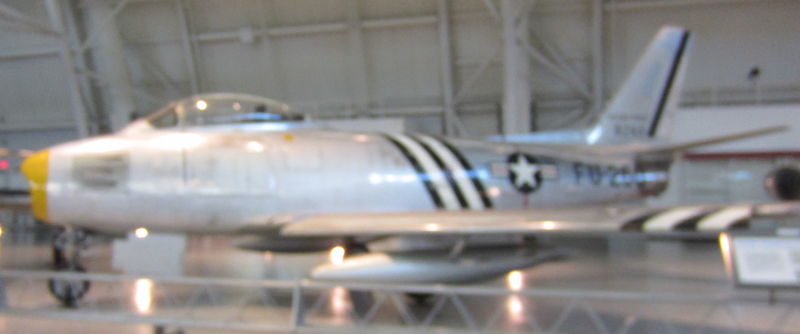
|
|
McDonnell F-45 Phantom II "Sageburner" Some aircraft are remembered for the large number produced, others for their length of time in service, and others for their ability to perform their mission. When one aircraft is known to be one of the leaders in all three categories, it stands out among others. The McDonnell Douglas F-4 Phantom II is such an aircraft. During the period 1959 to 1969, the F4H and its derivatives established many altitude and speed records. Like the F-4B, the F-4C had no built-in gun but carried Sparrow missiles as its primary attack weapon. The F-4J was the last fighter version to be placed in quantity production for the US Navy and Marine Corps. In 1968 the Navy chose the F-4J for its "Blue Angels" flight demonstration team and in 1969 the USAF chose the F-4E for its "Thunderbird" team. England, Iran, South Korea, Spain, Australia, Israel, Japan, Greece, Turkey, and West Germany have purchased the F-4. The F-4E was the model preferred by overseas air forces. In 1961, as part of the commemoration of 50 years of Naval Aviation, the Navy sponsored a project known as Sageburner. This project was designed to set new speed records at low altitudes flying F-4A Phantoms (F4H-1). On May 18, the initial attempt ended in tragedy when Commander J. L. Felsman was killed when pitch dampener failure led to pilot-induced oscillations (PIO), causing his Phantom to break up in flight and explode. The second attempt to set a new low-altitude speed record succeeded on August 28, 1961, when Lt. Huntington Hardisty (pilot) and Lt. Earl De Esch (RIO) flew F4H-1F BuNo 145307 at an average speed of 902.760 mph over a 3 km low-altitude course at the White Sands Missile Range in New Mexico. The maximum altitude reached during this flight was only 125 feet, fully living up to the name of the project-Sageburner. The F-4A (BuNo 145307) was later turned over to the National Air and Space Museum and is preserved in storage at the Paul Garber Restoration Facility at Suitland, Maryland. Photo 161 |

|
|
Vought F-8G Crusader The F8U Crusader was the first carrier-based jet fighter to exceed 1,600 kilometers (1,000 miles) per hour. Its variable-incidence wing, which could elevate up to seven degrees in the front while rotating about its rear spar, helped improve the aircraft's flight characteristics at slow speeds and increase pilot visibility for takeoff and landing. Its folding outer wing tips facilitated storage on aircraft carriers. Improvements were made to the engines and radar, and ventral fins were added under the tail for increased directional stability. Of the 1,261 Crusaders built, 73 were modified as RF-8G reconnaissance models. This RF-8G was the last operational Navy F-8. Delivered as an F8U-1P, it spent its first seven years with the Marine Corps and flew 400 combat hours in Southeast Asia. Its career total of 7,475.2 flight hours is the most of any U.S. Navy Crusader built. Photo 169 |
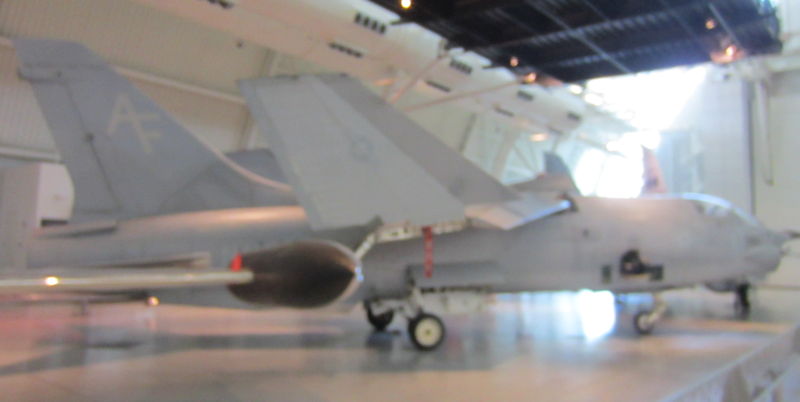
|
|
Locheed Martin X-35B Joint Strike Fighter This aircraft is the first X-35 ever built. It was originally the X-35A and was modified to include the lift-fan engine for testing of the STOVL concept. Among its many test records, this aircraft was the first in history to achieve a short takeoff, level supersonic dash, and vertical landing in a single flight. It is also the first aircraft to fly using a shaft-driven lift-fan propulsion system. The X-35B flight test program was one of the shortest, most effective in history, lasting from June 23, 2001 to August 6, 2001. Photo 170 |
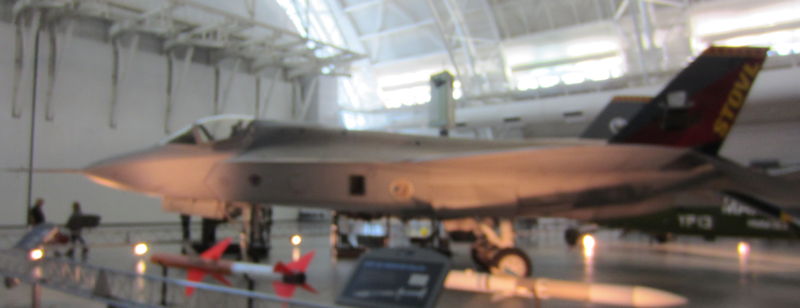
|
|
Locheed Martin X-35B STOVL Propulsion System
Photo 175 |
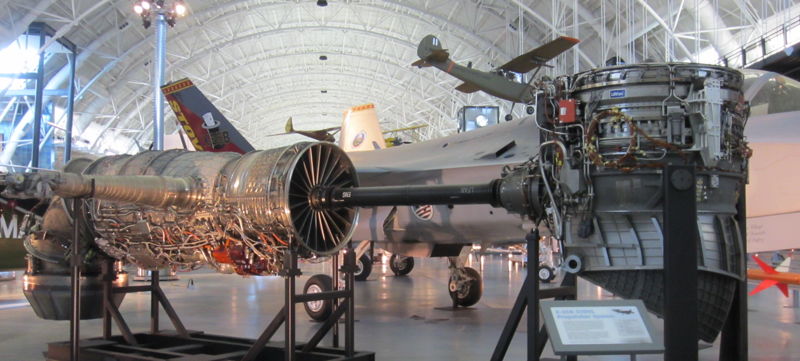
|
|
Grumman F-14D(R) Tomcat The National Air and Space Museum's Tomcat (BuNo. 159610) was built as an F-14A-85-GR and was one of the few Tomcats that was modified as an F-14D(R) in the early 1990s. It is credited with one MiG kill which was earned on January 4, 1989, near the coast of Libya. On January 4, 1989, near the Libyan coast, Two VF-32 F-14As flying CAP from the USS John F. Kennedy (CV-67) are alerted to a pair of Libyan Mikoyan-Gurevich MiG-23 Floggers. The MiG-23s had taken off from Al Bumbaw Airfield near Tobruk. The F-14s locked the MiGs with their powerful AWG-9 radar. Normally such a radar lock resulted in the MiGs retreating back to Libya--not this tme. The Tomcats were threatened by the AA-7 Apex missile-carrying Floggers and were cleared to engage the MiGs. During a lengthy six- to eight-minute air battle, the MiGs continued to threaten the Tomcats and finally, after several attempts to evade the MiG radar threat, the incoming pair of MiG-23s were declared hostile and the F-14 crews were cleared to engage. The crew of the lead F-14A, AC202 fired an AIM-7 Sparrow missile which did not stike its target, while the second F-14A's, AC207 (BuNo. 159610) AIM-7 found its target destroying one of the MiG-23s. The lead F-14 re-engaged the remaining MiG-23 firing an AIM-9 Sidewinder heat-seeking missile which detonated in the tailpipe of the Flogger. Both MiG pilots ejected safely from their destroyed aircraft. Photo 173 |
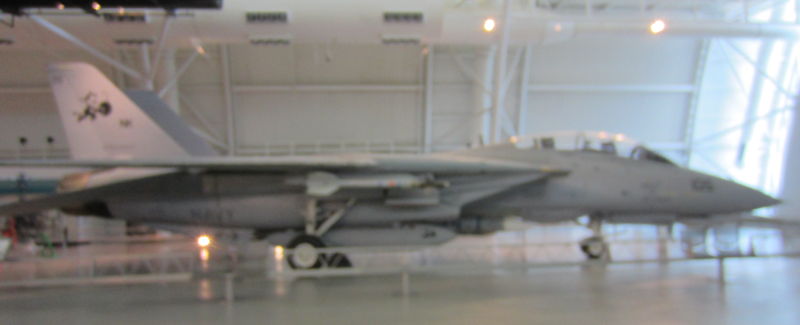
|
|
North American F-100D Super Sabre The F-100D was widely used in Vietnam. A typical mission found the F-100D approaching the target at very low altitude at approximately 500 mph. The pilot would then elevate the nose of the aircraft by using a 4G pull up. Partway into the "toss" maneuver, the computer would automatically release the bomb. The F-100D was equipped with a Minneapolis-Honeywell MB-3 automatic pilot. This device provided the capability to allow the pilot to work with both hands on maps reading or weapons arming while the F-100D flew itself to the target. While flying in formation with other aircraft, the autopilot was not used. By the early 'sixties, the F-100D had been subjected to so many in-service modifications to correct its obvious deficiencies that no two F-100Ds were identical. Over five hundred were lost in accidents between mid-1956 and mid-1970, far more than were lost in combat in Vietnam. Photo 177 |
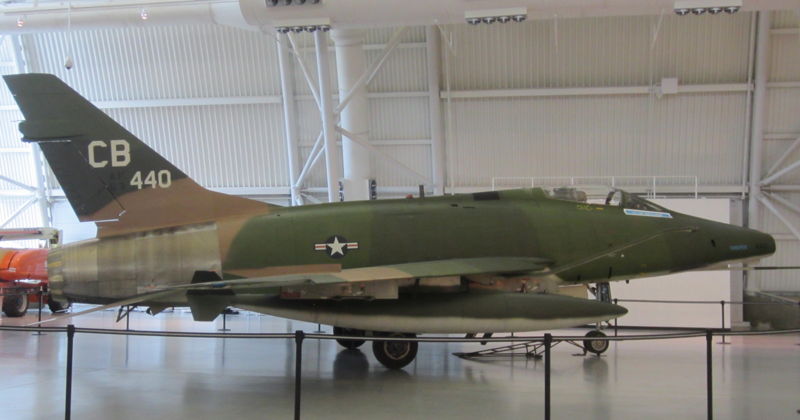
|
|
Republic F-105D Thunderchief The F-105 was designed as a supersonic, single-seat, fighter-bomber capable of carrying nuclear weapons or heavy bomb loads at supersonic speeds. The F-105D variant was an all-weather fighter-bomber version, fitted with mono-pulse and Doppler radar for night or bad weather operations. The original weapons bay, designed for nuclear stores, was sealed and fitted with additional fuel tanks. Bombs were carried on multiple weapons racks on the centerline of the fuselage, and on wing pylons. The aircraft was fitted with a retractable in-flight refueling probe. The first F-105D flew on 9 June 1959 and 610 F-105Ds were eventually built. This aircraft has served in several F-105 units around the world and is restored to its 1967 Vietnam-era 388th Tactical Fighter Wing, 421st Tactical Fighter Squadron camouflage as it flew during its assignment to Korat RTAB, Thailand. This jet also was briefly assigned to the 355 TFW located at Takhli RTAB in 1968. After this "Thud" finished its combat tour-which certainly included missions supporting Operation "Rolling Thunder," "Steel Tiger," and "Barrel Roll"-it returned stateside and began more than a decade assigned to the District of Columbia Air National Guard and was transferred to the Air and Space Museum in late 1981. Photo 180 |
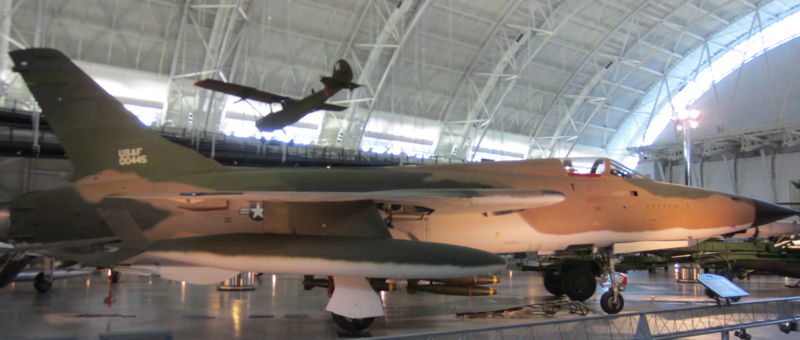
|
|
Mikoyan-Gurevich MiG-15bis "Fagot B" Arch rival to the U.S. F-86 in Korea, the MiG-15 shocked the West with its capabilities. The Soviets designed the aircraft in 1946 to answer an urgent need for a high-altitude day interceptor. It first flew in late 1947. The MiG-15 was the first Soviet jet to benefit from the British sale to Russia of the new Rolls Royce Nene and Derwent jet engines, which the Soviets immediately copied and refined. The resulting RD-500, Klimov RD-45, and modified VK-1 engines gave a powerful boost to Soviet jet technology. The MiG-15 featured the first production swept wing, pressurized cockpit, and ejection seat on a Soviet aircraft. Although Mikoyan and Gurevich were aware of German turbojet and swept-wing work, this design was wholly Russian, except for the engine. This MiG-15bis is a Chinese Ji-2 modification. The Smithsonian acquired it in 1985. Photo 158 |
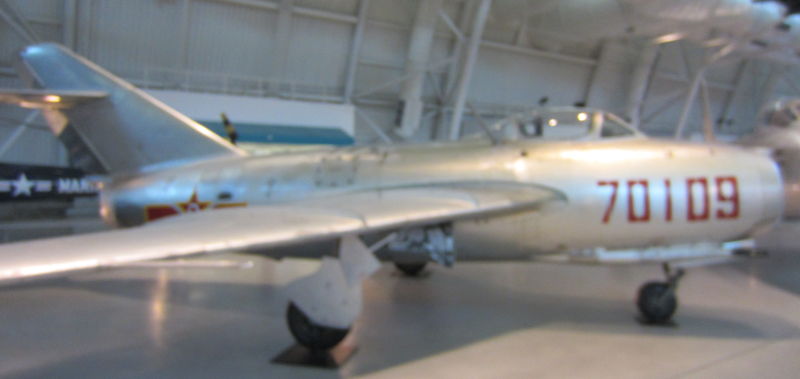
|
|
Mikoyan-Gurevich MiG-21F "Fishbed C" The MiG-21 was the Soviet Union's first truly modern, second-generation jet fighter. Testing began in 1956, and the first version entered service in 1960 as the MiG-21F-13. Soviet designers developed a unique "tailed delta" configuration with a very thin delta wing, which gave the aircraft maneuverability, high speed, good medium-altitude performance, and adequate takeoff and landing characteristics. The MiG-21 became the standard Soviet clear-air interceptor. With the addition of radar, more powerful engines, and other modifications, it became a multi-role fighter. More than 6,000 MiG-21s of 12 types were flown by over three dozen nations. This MiG-21F-13 was displayed in a Soviet military hardware exhibit at Bolling Air Force Base, Maryland, as part of a "Soviet Awareness" training program. Its service history remains unknown. Photo 155 |
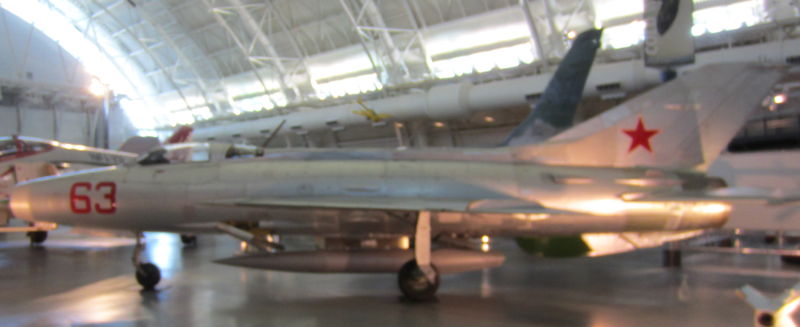
|
|
Sukhoi Su-26M The Sukhoi Design Bureau, makers of Soviet and Russian military aircraft, designed the Su-26 in 1983 for unlimited aerobatic competition. The Su-26M is made of more than 50 percent composite materials and has a special symmetrical wing section and arched cantilever titanium landing gear. It was designed to handle loads from +12 Gs to -10 Gs and is a superior aircraft for the most highly skilled pilot. It can perform spectacular gyroscopic maneuvers and quick, multiple snap rolls, and can nearly hover from its propeller. Soviet pilots flew Su 26Ms to multiple aerobatic titles. This Su-26M was built in 1990 and was originally painted in the unique "Russian purple" color. The Soviet National Aerobatic team flew 222 flights in the aircraft in 1990 and 1991. U.S. aerobatic pilot Gerry Molidor bought it in 1998 and flew it in advanced and unlimited competition until 2001. Photo 215 |
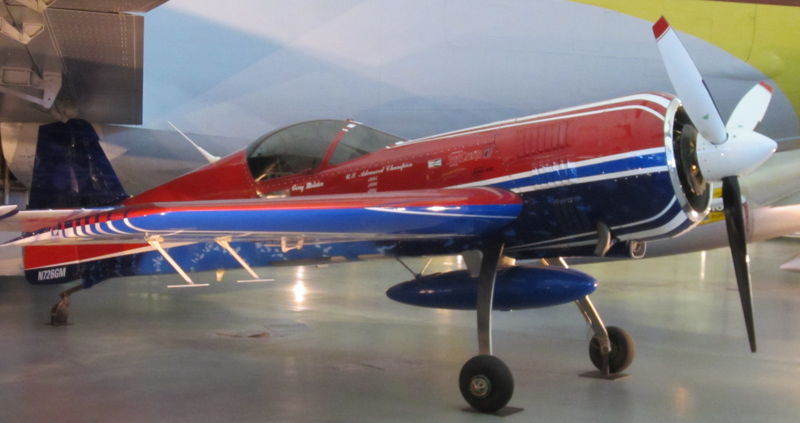
|
|
Loon Missile JB-2 The Loon, also called the JB-2 or KUW-1, was an American copy of the German pulsejet-powered V-1 or "Buzz Bomb" of World War II. It was designed to carry a 2,200-pound high explosive warhead to a range of 150 miles and could be launched from the ground, ships, or aircraft. The air-breathing pulsejet motor is the long tube at the rear. The development of the Loon came too late for use in World War II, and it was not used in combat. However, it provided invaluable experience to U.S. Navy and Army Air Force (and later, Air Force) personnel in the handling of missiles. The Loon was cancelled in 1950. This object was donated to the Smithsonian in 1965 by the U.S. Naval Supply Center. Photo 135 |
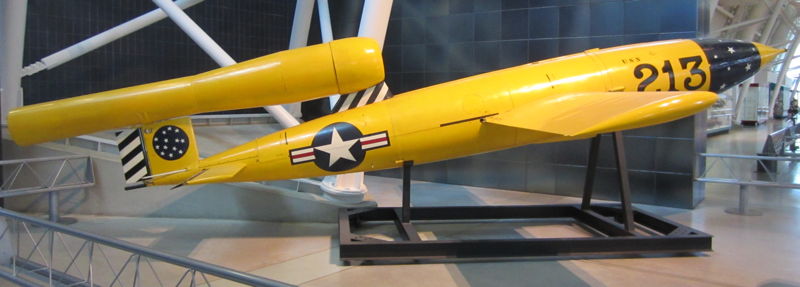
|
|
AGM-86A Cruise Missile This is the AGM-86A, the first version of the U.S. Air Force's air-launched cruise missile (ALCM) and built by Boeing. Launched from B-52 bombers, the missile had a nuclear warhead, a turbofan jet engine, a range of approximately 2,400 km (1,500 miles), and two navigation systems that enabled it to fly close to the ground making it difficult for enemy radars to pick up. First deployed in 1982, some of the missiles began to be converted in 1986 to the AGM-86C with a conventional warhead and a Global Positioning System-aided navigation system. This missile was the second flight model tested and was transferred to NASM by the U.S. Air Force in 1982. Photo 149 |
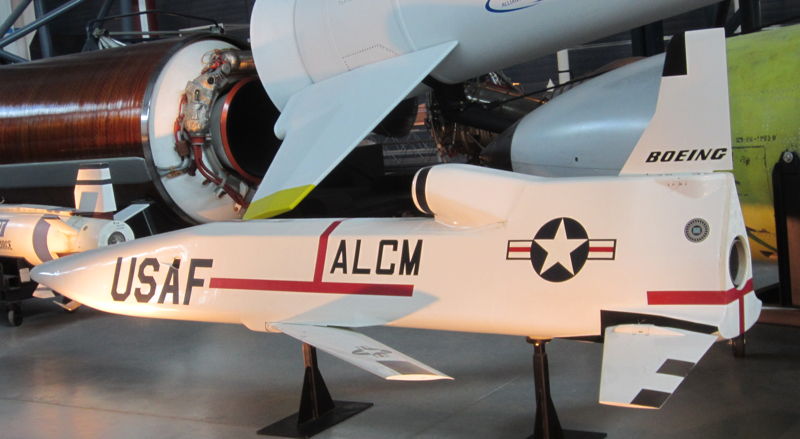
|
|
Styx Missile This is the Styx, a surface-to-surface, anti-ship missile that became operational with the former Soviet Navy in 1958. A solid-fuel booster (not shown here) launched the missile, and a built-in rocket engine sustained its flight. It had a range of about 26 miles. The Soviet Union supplied its allies with Styx missiles. An Egyptian Styx sank the Israeli destroyer Eilat during the Six-Day War in 1967. They were also used during the Vietnam and Persian Gulf wars and during conflicts between India and Pakistan. The People's Republic of China produced its own versions of the Styx. This object was donated to the Smithsonian in 1995 by the U.S. Air Force. Photo 151 |
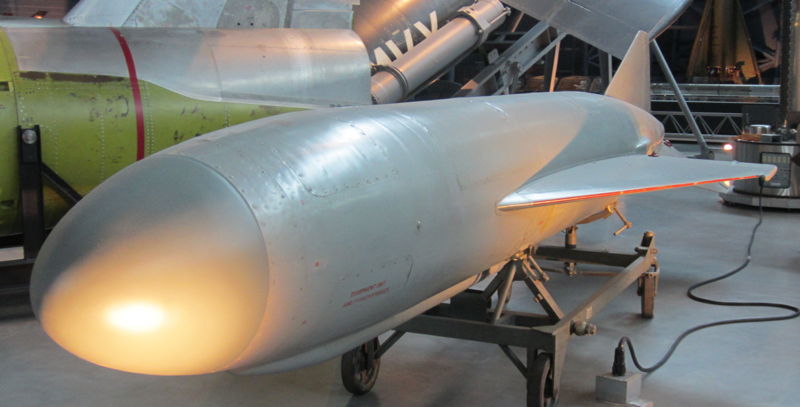
|
|
Atoll Missile This is the Atoll, an air-to-air missile of the former Soviet Union. Atoll is the NATO code name for the Soviet K-13, a copy of the U.S. Sidewinder air-to-air, heat-seeking missile. Atoll originated in 1958, when a Sidewinder fired from a Taiwanese F-86 fighter in the Taiwan Strait lodged in an aircraft of the People's Republic of China but did not detonate. China recovered the missile intact and turned it over to the Soviet Union, which copied the design, mass-produced the missile, and exported Atolls to its client states. The Atoll has the same basic dimensions as the Sidewinder but has been modified over the years and is still in use. This object was donated to the Smithsonian in 1993 by the U.S. Air Force. Photo 154 |
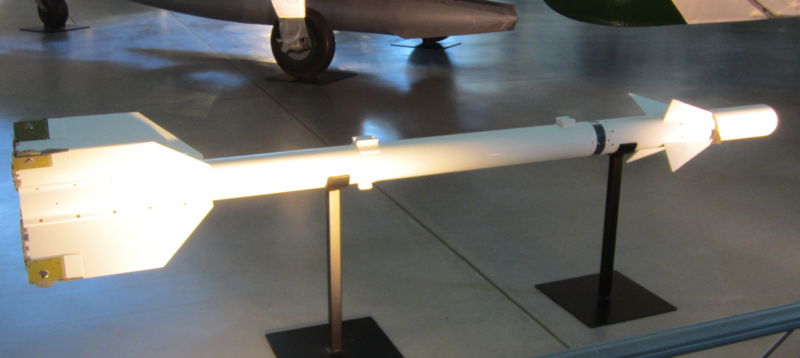
|
|
Sidewinder Missile This is a Sidewinder air-to-air missile, also designated AIM-9E. The blue stripe indicates it was a training model. The Sidewinder has been one of the most successful short-range, air-to-air missiles and was the first heat-seeking guided missile to become operational. Many models have been produced since the mid-1950s. A variety of aircraft have carried Sidewinders, and variants have been adopted by about 40 countries. They have been used extensively in combat, including the Vietnam and Persian Gulf wars. This object was donated to the Smithsonian in 2003 by the U.S. Air Force Museum. Photo 163 |
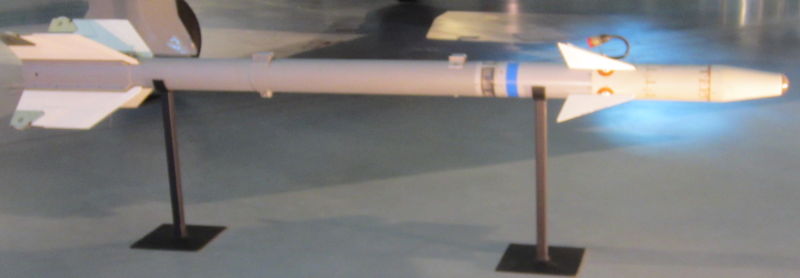
|
|
Space Shuttle Discovery
Photo 141 |
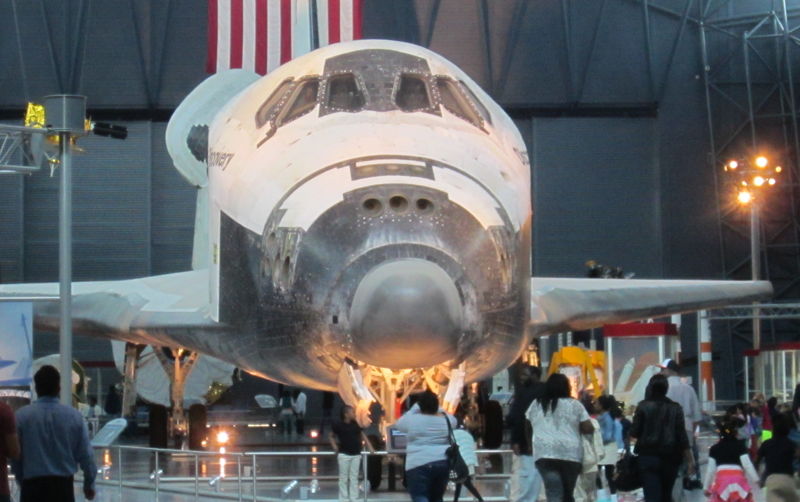
|
|
Space Shuttle Discovery
Photo 142 |
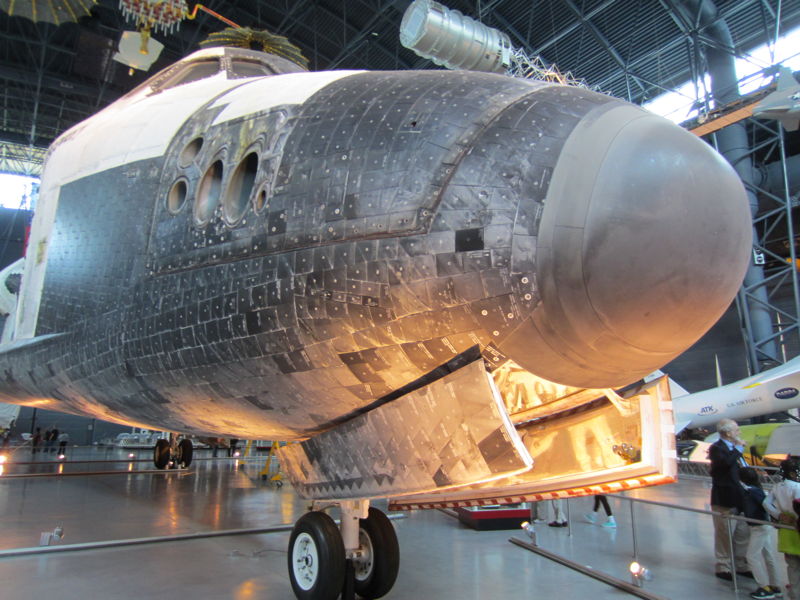
|
|
Space Shuttle Discovery
Photo 143 |
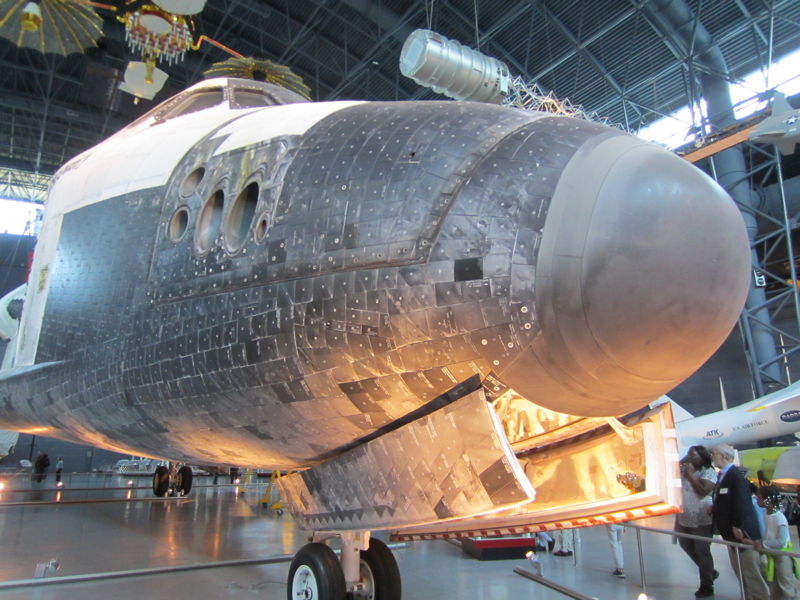
|
|
Space Shuttle Discovery
Photo 144 |
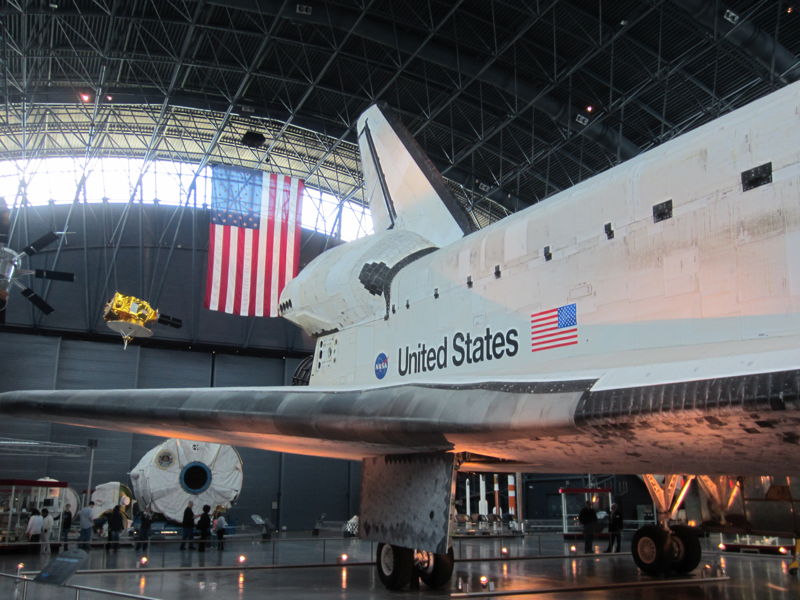
|
|
Space Shuttle Discovery Tiles Photo 146 |
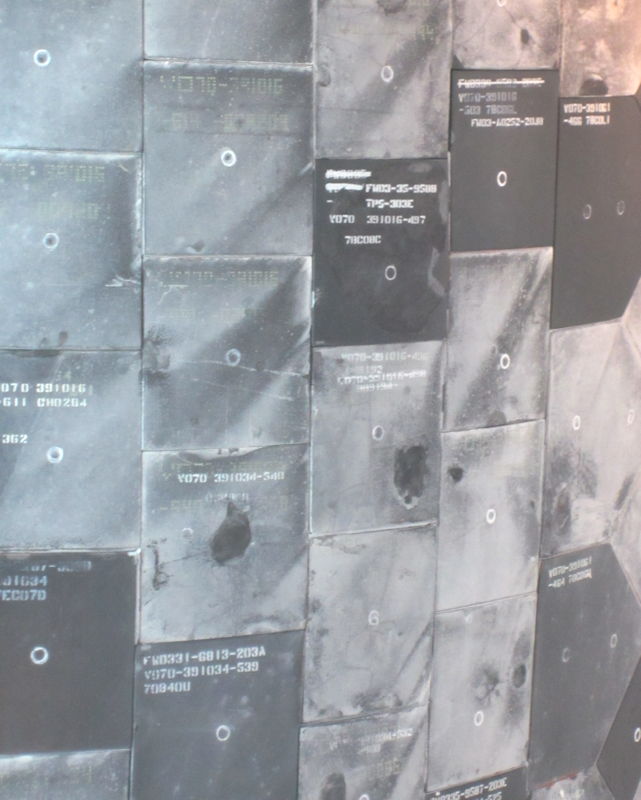
|
|
Apollo Boilerplate Command Module As part of the Apollo program, a number of so-called "boilerplate" (BP) command modules were constructed to undergo various tests and to serve as training vehicles for astronauts and other mission crew members. BP 1102A is constructed of aluminum, with its sidewalls painted with a bronze epoxy paint to simulate the look of a real Apollo Command module after splashdown. It was fitted with an actual Command Module hatch. The initial use of BP1102A was as the water egress trainer for all Apollo flights, including by the crew of Apollo 11, the first lunar landing mission. As such, it was fitted with actual or mock-up interior components and used by astronauts to practice routine and emergency exits from the spacecraft. Subsequently, the interior was set up to be configured either as Apollo/Soyuz or a five-man rescue vehicle as once proposed for Skylab so that astronauts could train for those missions. It was finally transferred from NASA to the Smithsonian in 1977 and is displayed now at the Hazy Center with the flotation collar and bags that were attached to Columbia at the end of its historic mission. Photo 147 |
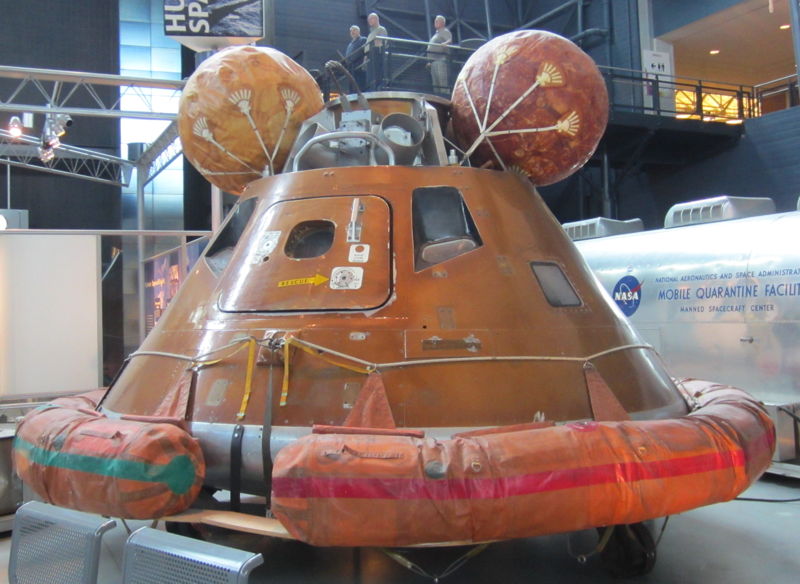
|